The Terramaster F4-425 PLUS NAS Review – The New $500+ NAS Standard?
The TerraMaster F4-425 Plus represents a significant step forward in the brand’s 4-bay NAS lineup, targeting users who demand capable hardware and broad feature support at a mid-range price point. Retailing at $569.99, or $484.99 during its introductory discount, it is positioned to compete directly with systems like the Synology DS925+ and QNAP TS-464, both of which occupy similar price and hardware tiers. TerraMaster’s intention with this model is to deliver a “jack of all trades” device that suits both home multimedia environments and small business offices. Internally, it uses Intel’s quad-core N150 processor, part of the newer Twin Lake architecture, with a base clock of 1 GHz and a turbo frequency up to 3.6 GHz. This CPU is paired with 16GB of DDR5 memory, offering a notable upgrade in bandwidth and responsiveness compared to previous DDR4-based TerraMaster models.
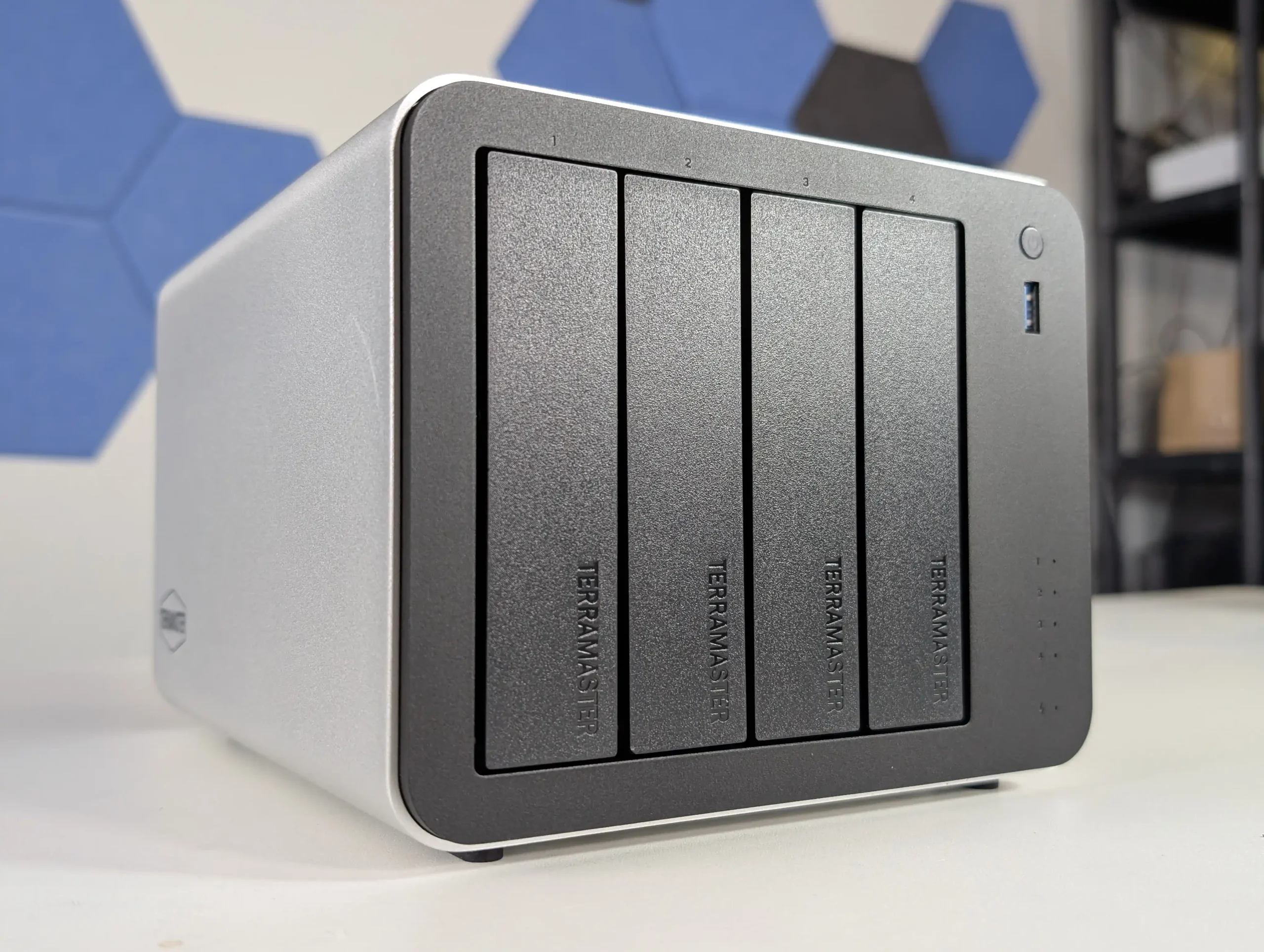
Complementing that performance core are three PCIe 3.0 x1 M.2 NVMe slots and four SATA drive bays, supporting a combined raw capacity of up to 144TB when fully populated. This configuration allows the device to accommodate both large-scale HDD storage for bulk data and high-speed SSD arrays for caching or dedicated performance pools. Dual 5GbE network ports on the rear enable theoretical aggregate transfer speeds exceeding 1,000 MB/s, aligning with the system’s positioning as a performance-focused yet affordable NAS. TerraMaster’s TOS 6 operating system comes preinstalled, providing modernized storage management, AI-based photo organization, and security tools like HyperLock WORM protection and isolation mode. Altogether, the F4-425 Plus arrives as one of the most fully featured mid-tier NAS options available in 2025, combining strong hardware, software maturity, and quiet, power-efficient design suited to both personal and professional use cases.
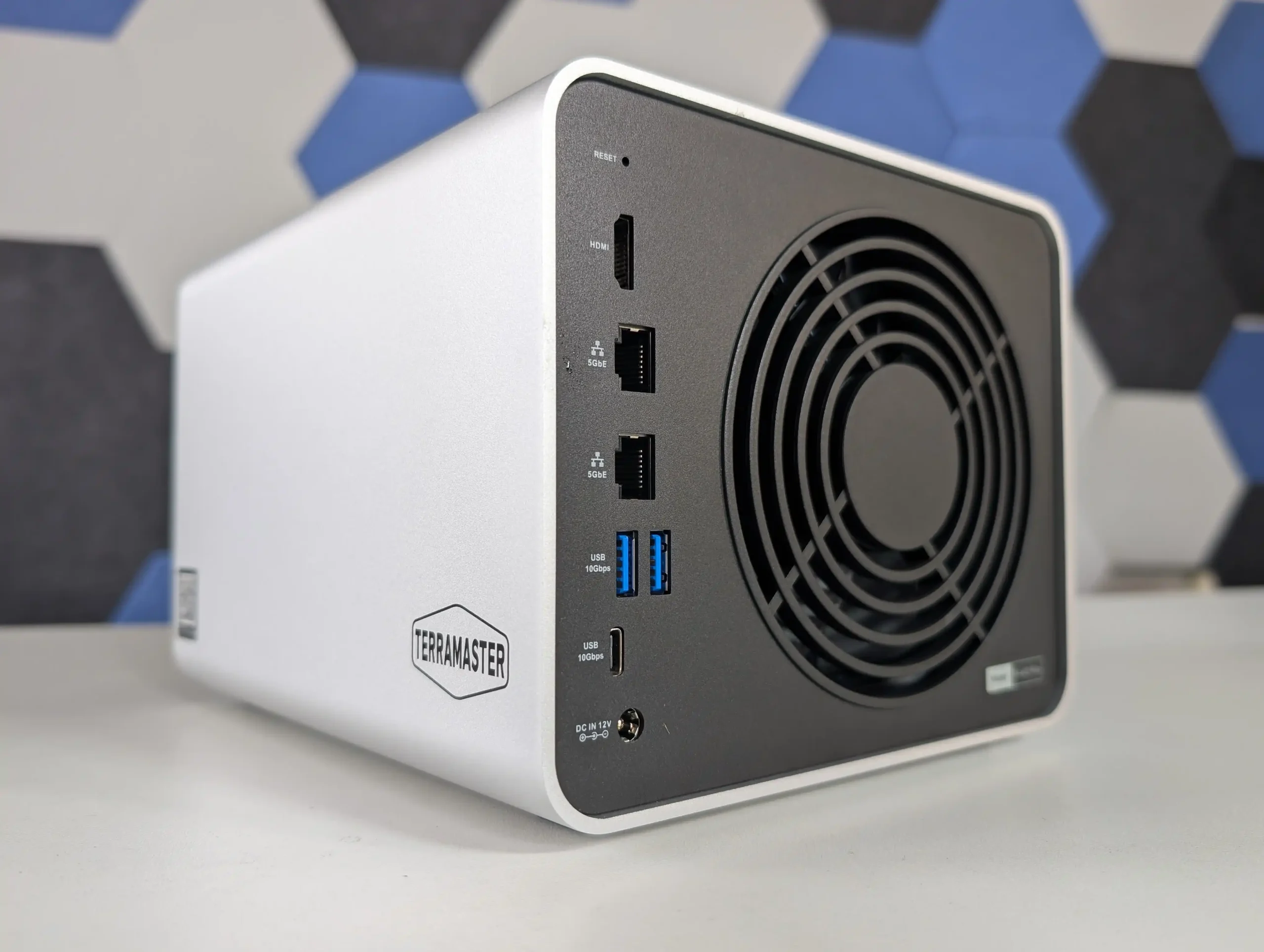
The Terramaster F4-425 PLUS NAS Review – Quick Conclusion
The TerraMaster F4-425 Plus delivers one of the most complete mid-tier NAS packages currently available, balancing strong hardware, efficient design, and flexible software at a highly competitive price. Its Intel N150 processor, 16GB of DDR5 memory, and dual 5GbE ports provide ample speed for data-heavy workloads, while three M.2 NVMe slots add rare versatility for caching or SSD-based pools. The all-metal enclosure maintains low temperatures and quiet operation, and the TOS 6 operating system has matured into a capable platform with snapshot protection, Docker, virtualization, and AI photo management. Although it lacks premium details such as drive locks and redundant fans, and the interface remains less refined than Synology DSM or QNAP QTS, the F4-425 Plus stands out as a practical and forward-looking NAS. It bridges affordability and professional capability, making it suitable for home users, content creators, and small offices that need reliable, fast, and adaptable network storage.
Where to Buy a Product





![]()
![]()

VISIT RETAILER ➤






![]()
![]()

VISIT RETAILER ➤






![]()
![]()

VISIT RETAILER ➤






![]()
![]()

VISIT RETAILER ➤
| Terramaster F4-425 PLUS NAS | ||
| Amazon in Your Region for the Terramaster F4 SSD NAS @ $569 ($489.99 till 19th Nov) | Terramaster F4-425 PLUS – $569 | B&H for the Terramaster F4-425 plus NAS @ $569.99 |
 |
 |
 |
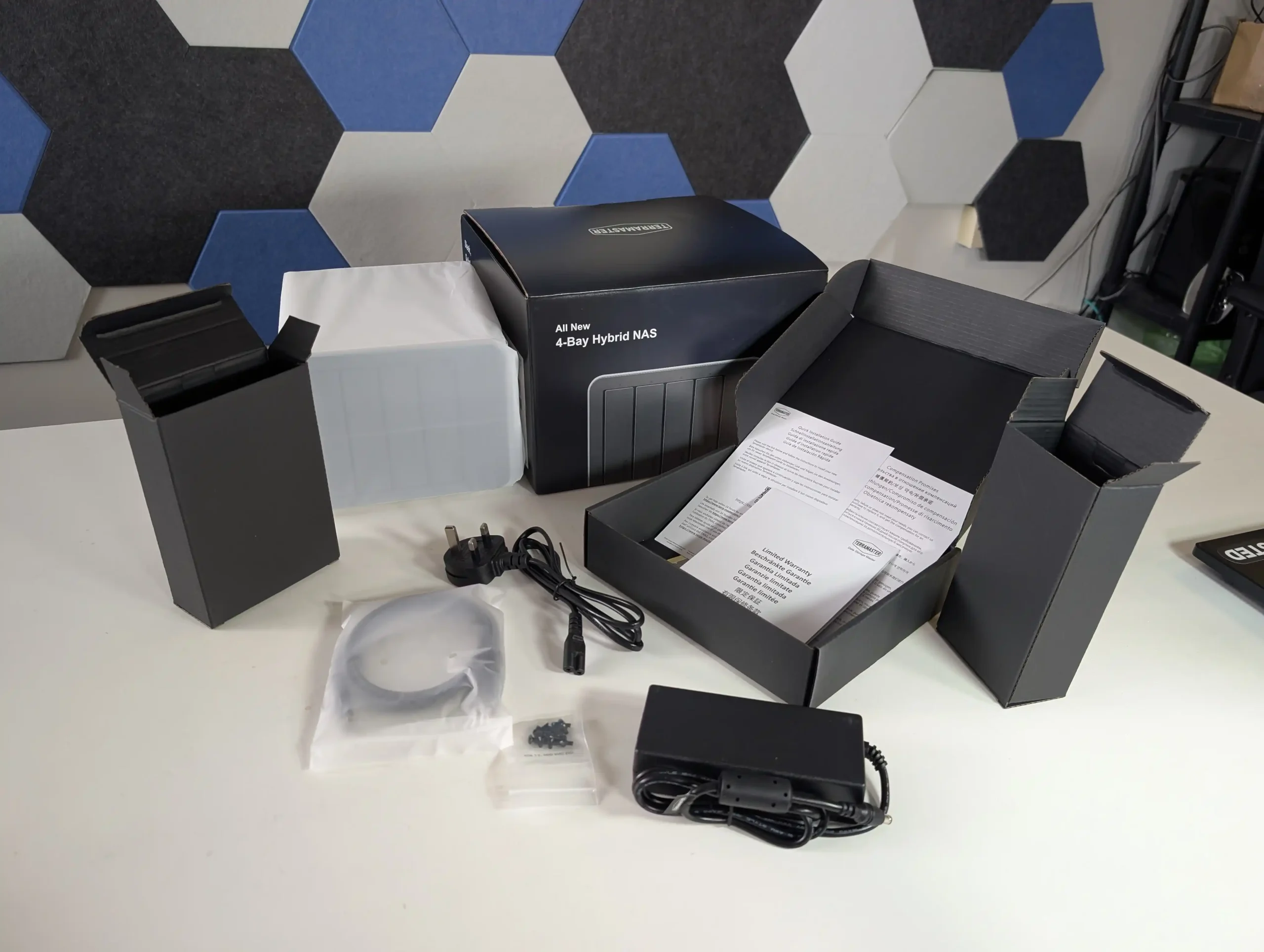
The Terramaster F4-425 PLUS NAS Review – Design & Storage
The exterior design of the TerraMaster F4-425 Plus maintains the brand’s familiar compact metal chassis but introduces small refinements that improve both usability and thermals. Measuring 150 by 181 by 219 millimeters and weighing just under 3 kilograms, it fits comfortably into a home office or studio setup without generating significant heat or noise. The enclosure is almost entirely metal, with a brushed silver finish that enhances rigidity and passive cooling compared with earlier plastic-faced designs. Four individual drive trays occupy the front panel, each featuring a simple click-and-load mechanism for 3.5-inch or 2.5-inch drives. Although there are no locking latches or LCD displays, the trays are tool-free and straightforward to handle. A single 120mm fan at the rear provides adjustable cooling across smart, low, and high-speed profiles, maintaining an operational noise level as low as 20.9 dB(A) when idle with drives installed, according to TerraMaster’s own test figures.
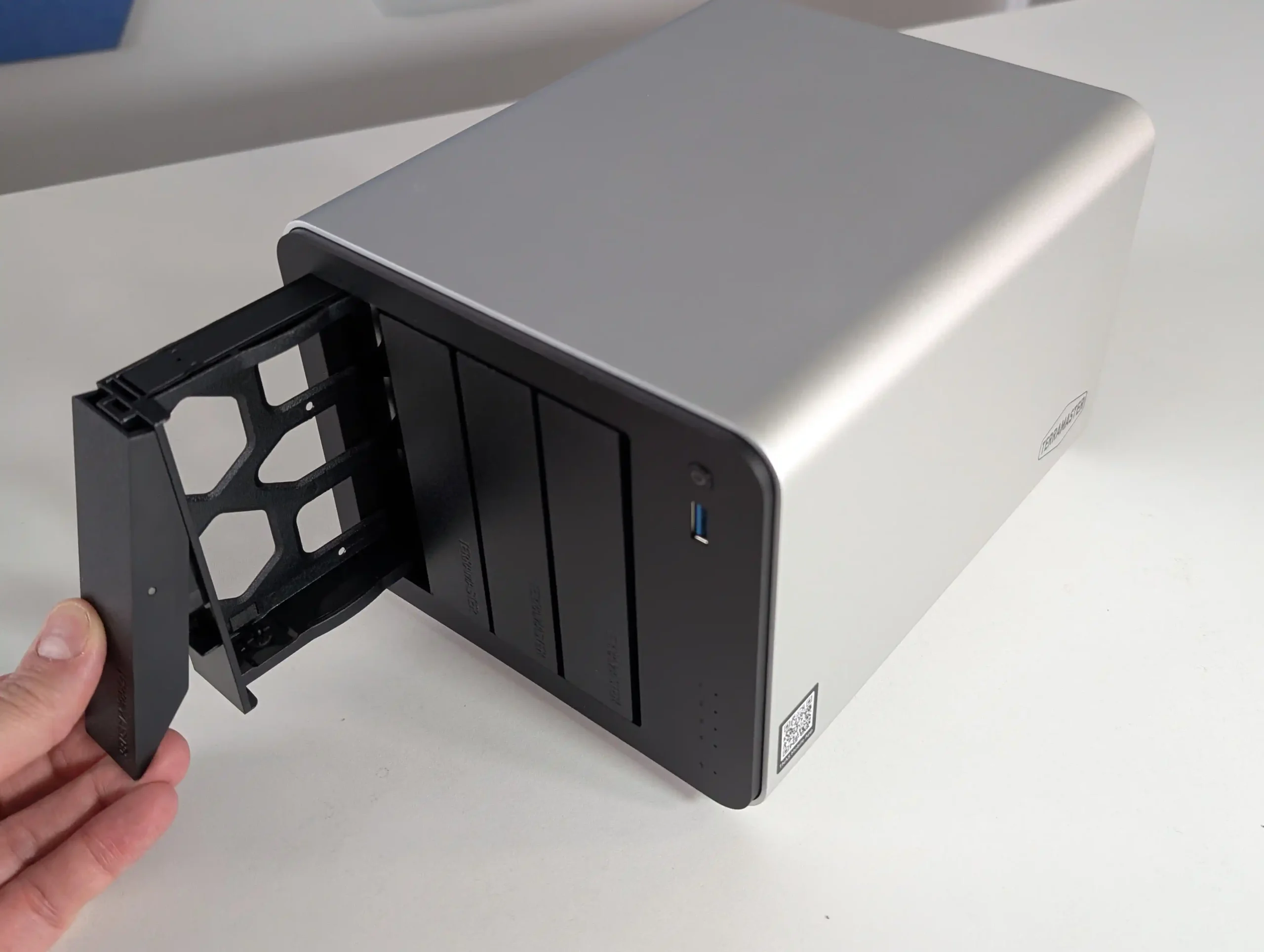
From a structural perspective, the F4-425 Plus has clearly benefited from improved thermal management. The metal shell acts as a heat spreader, with typical external temperatures ranging from 25 to 27°C across the enclosure after extended operation, even under multi-day workload testing. Internal drive bays were observed to maintain around 27 to 29°C, while the rear ports and fan area registered between 36 and 38°C during prolonged use. These figures indicate an efficient heat dissipation design, aided by the more conductive chassis material and smart fan calibration. For users concerned with energy efficiency, the power draw remains modest thanks to the Intel N150 processor’s low TDP, allowing the system to idle at roughly 13 watts with SSDs installed and scale to around 60 watts under sustained load with four enterprise-class HDDs spinning.
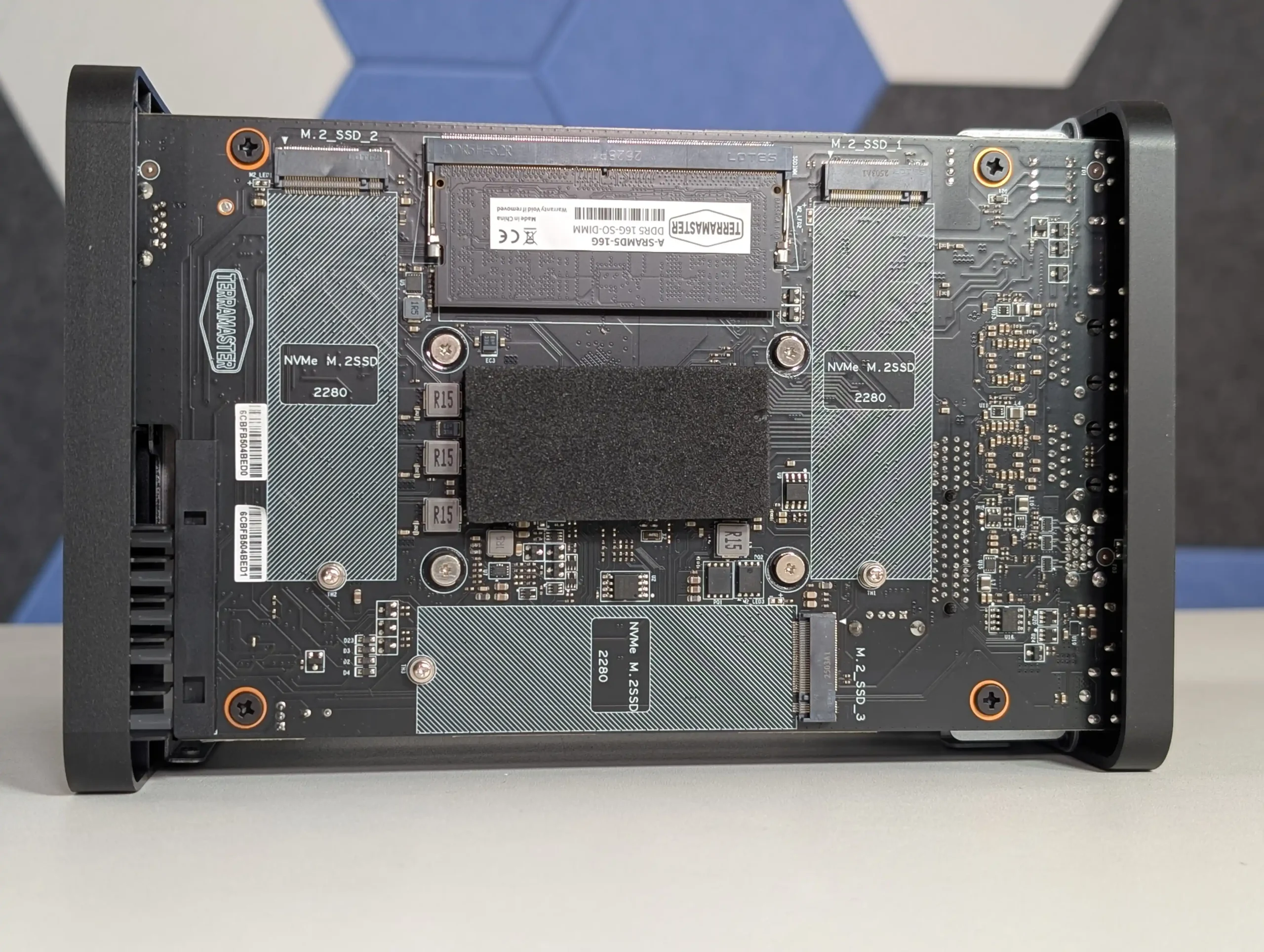
In terms of drive configuration, the NAS supports up to four SATA 6Gb/s drives and three M.2 2280 NVMe SSDs. This combination provides a theoretical maximum raw capacity of 144TB, assuming four 30TB HDDs and three 8TB SSDs. The inclusion of three NVMe slots rather than the more typical one or two is a notable strength. Each operates on a PCIe 3.0 x1 lane, delivering real-world throughput of approximately 800 to 900 MB/s per SSD, suitable for caching or storage pools. This setup makes it possible to allocate two drives for cache acceleration while dedicating the third to an independent SSD-based pool for high-speed operations like video editing or database hosting. Such flexibility is rare at this price point and broadens the system’s appeal to users with both large data sets and high-performance requirements.
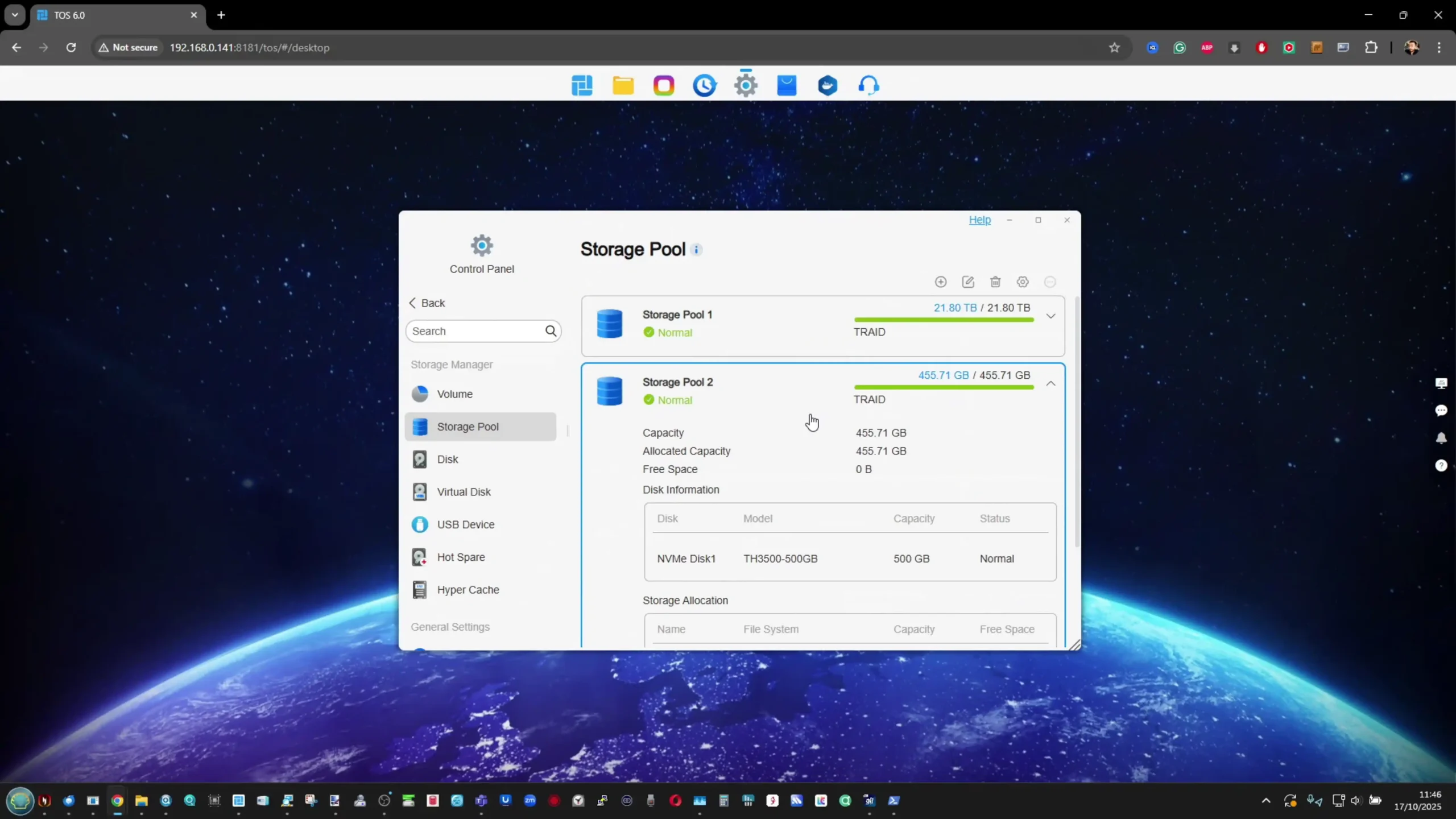 |
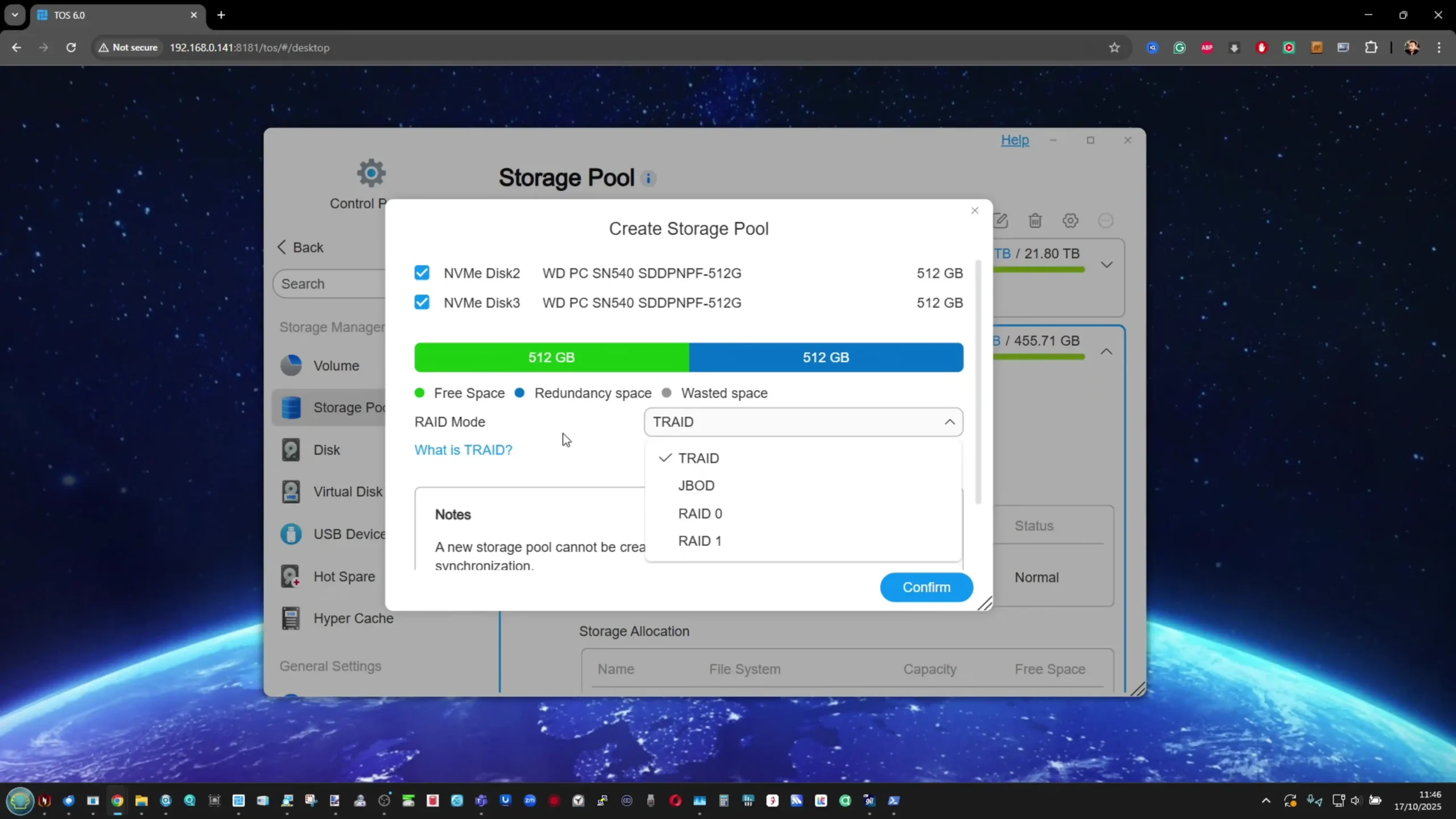 |
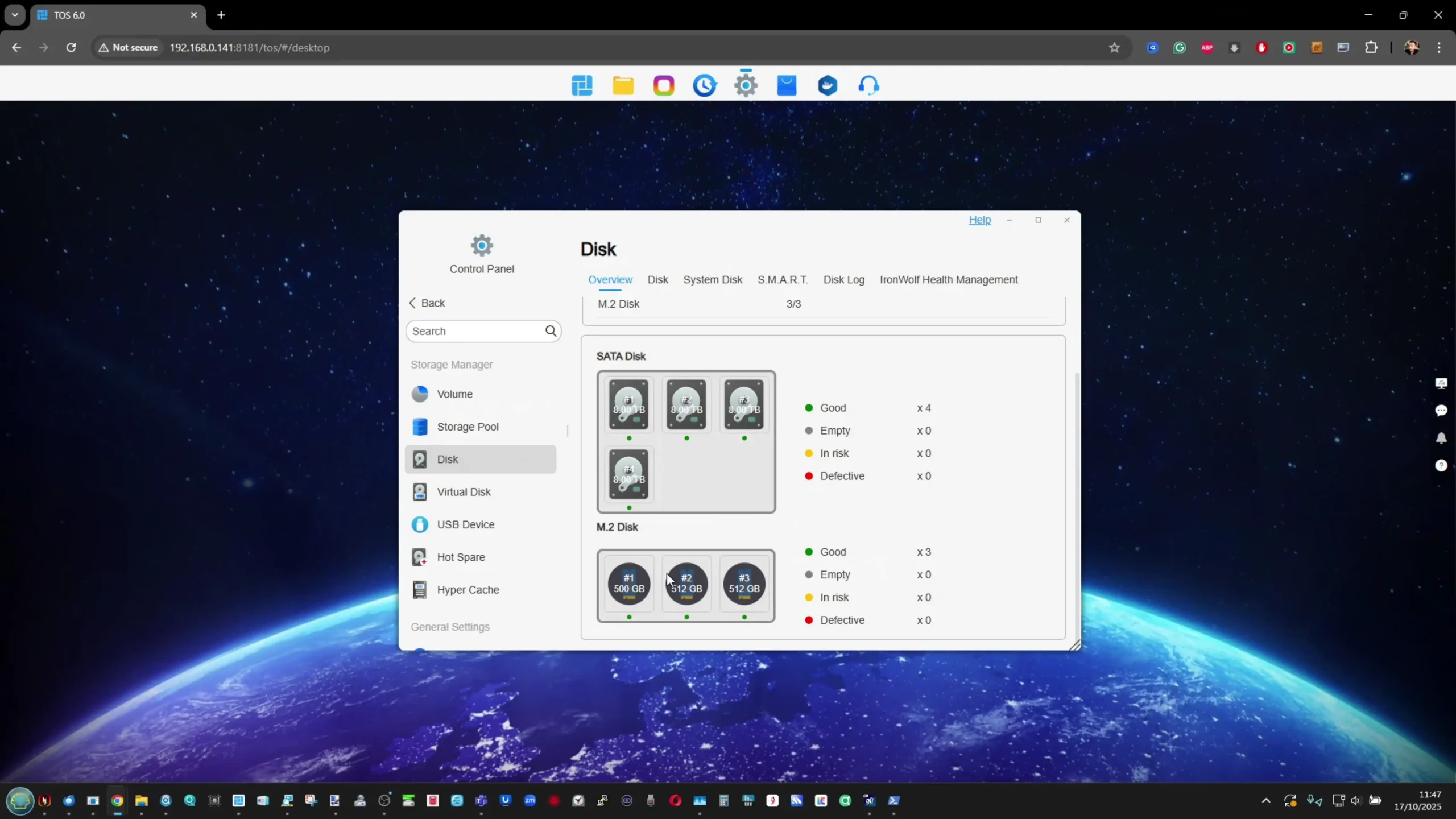 |
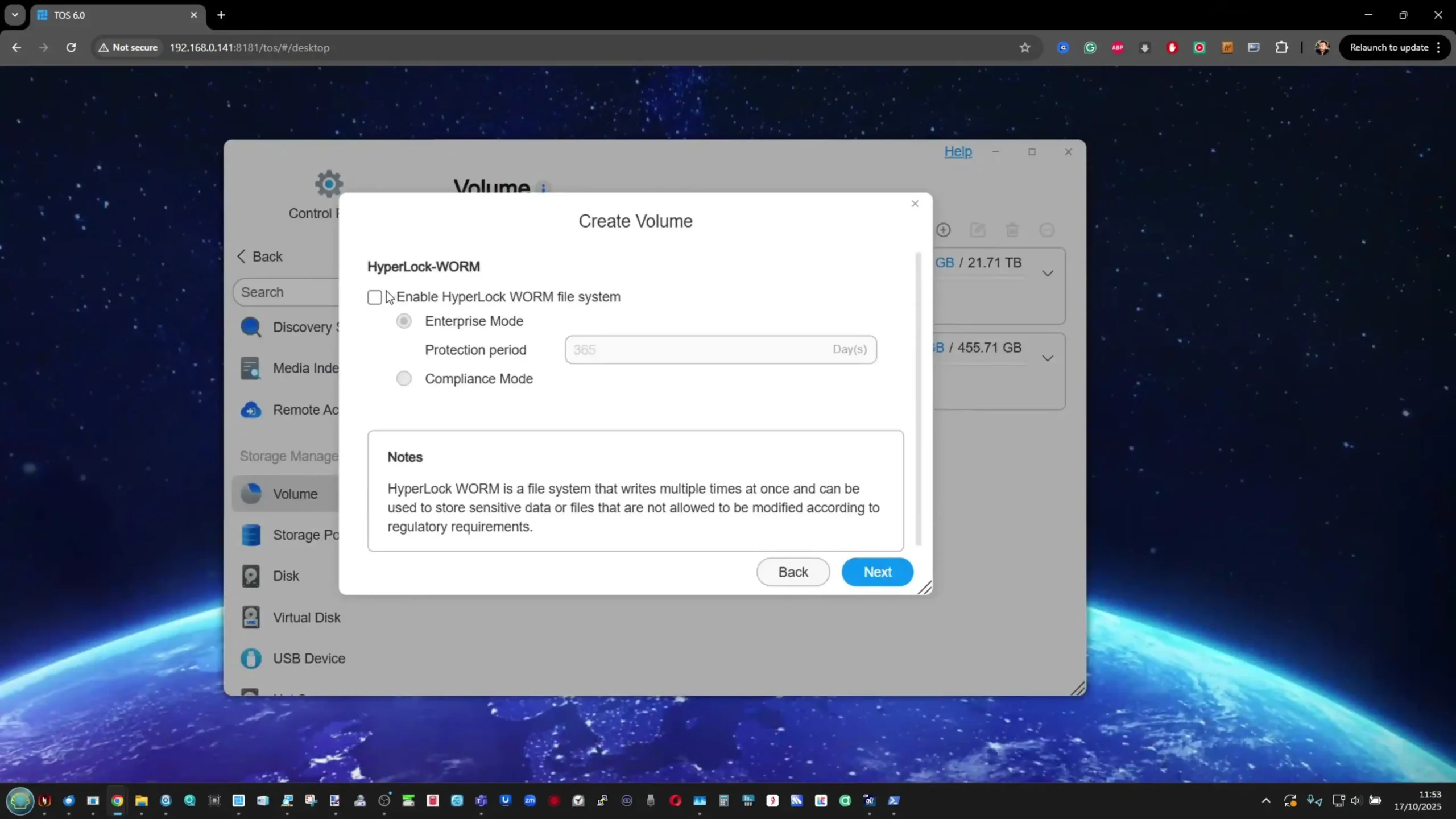 |
Storage management is handled through TOS 6, TerraMaster’s web-based operating system, which supports a wide range of RAID configurations including TRAID, TRAID+, JBOD, and traditional RAID 0, 1, 5, 6, and 10. TOS 6 also enables SSD caching, snapshots, and HyperLock write-once-read-many functionality for data integrity. Users can assign storage pools to specific workloads, such as separating SSD-based scratch space from HDD archival volumes. Combined with the new graphical interface and more detailed health monitoring tools, it provides a much more transparent overview of drive temperatures, utilization, and S.M.A.R.T. status. For additional flexibility, the system supports online RAID migration and expansion, meaning users can start small and scale capacity over time without data loss.
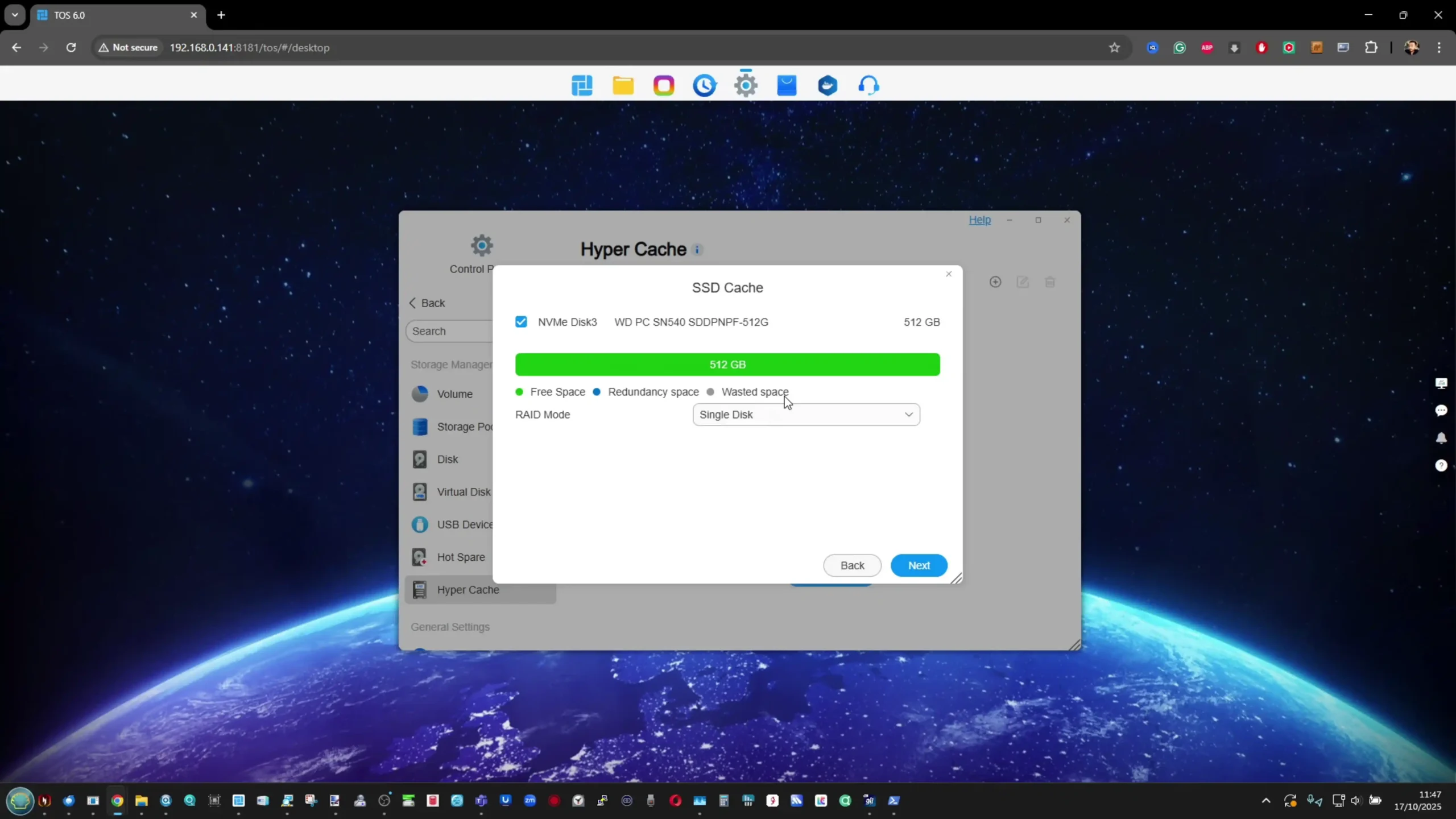 |
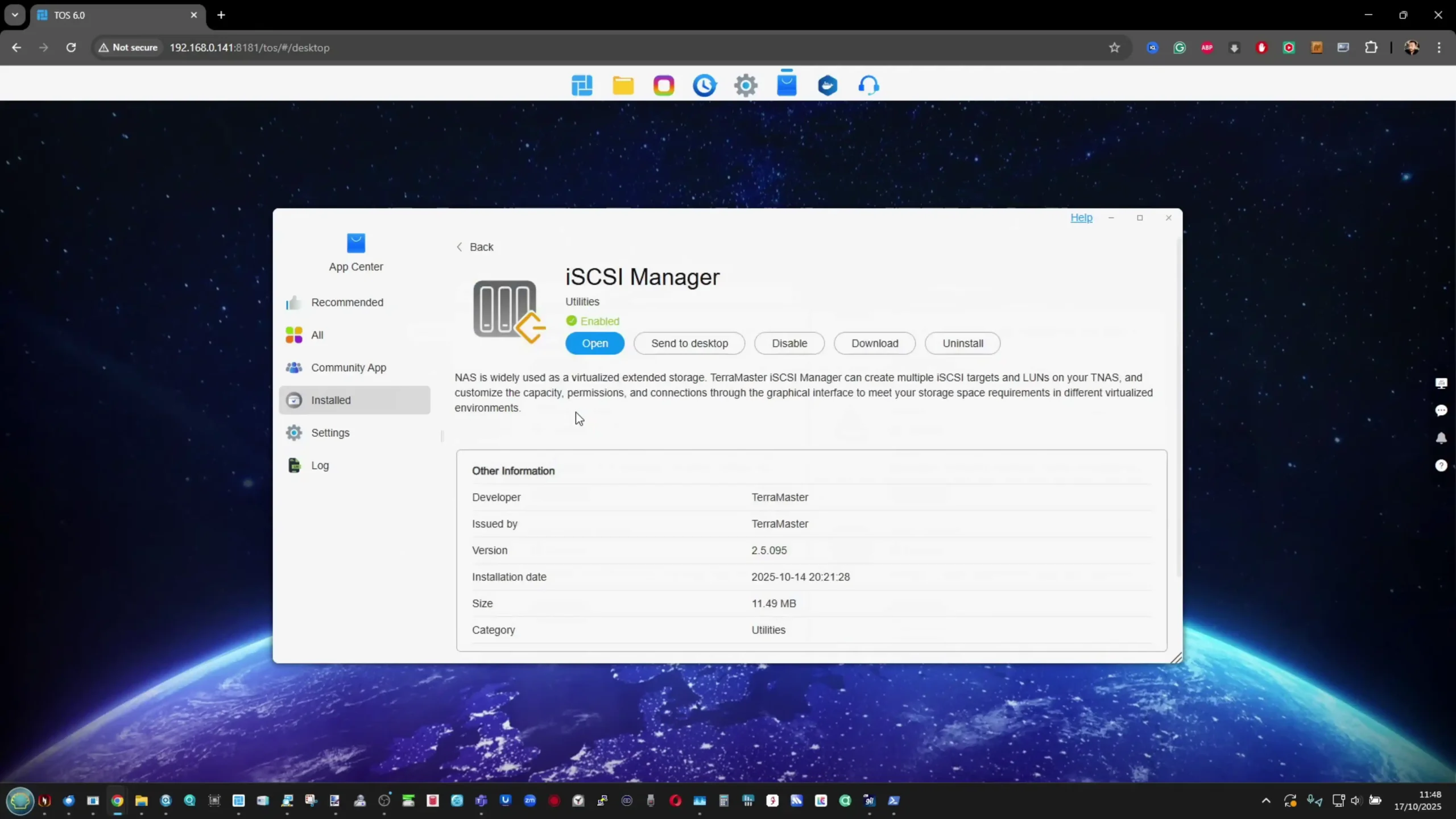 |
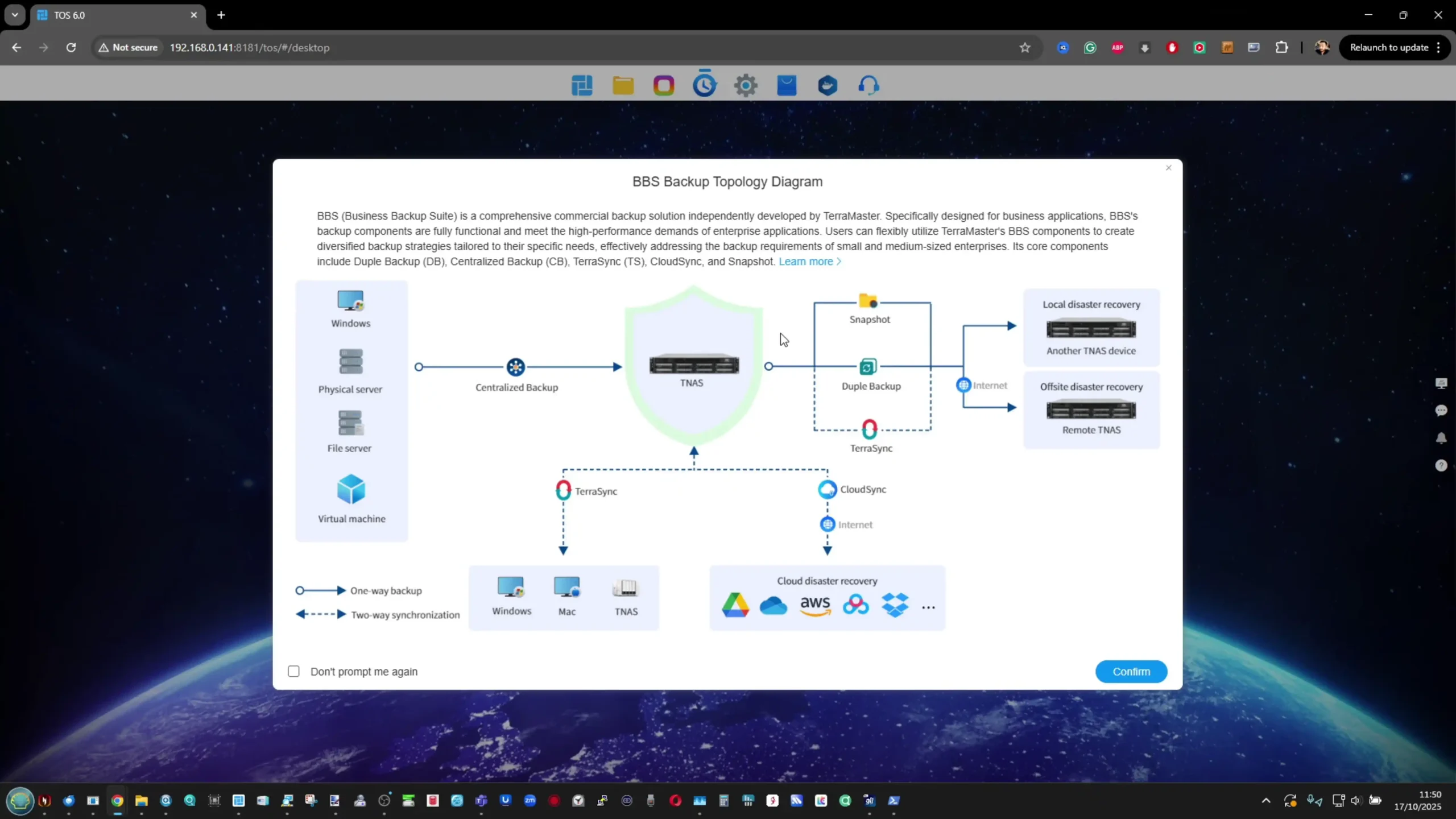 |
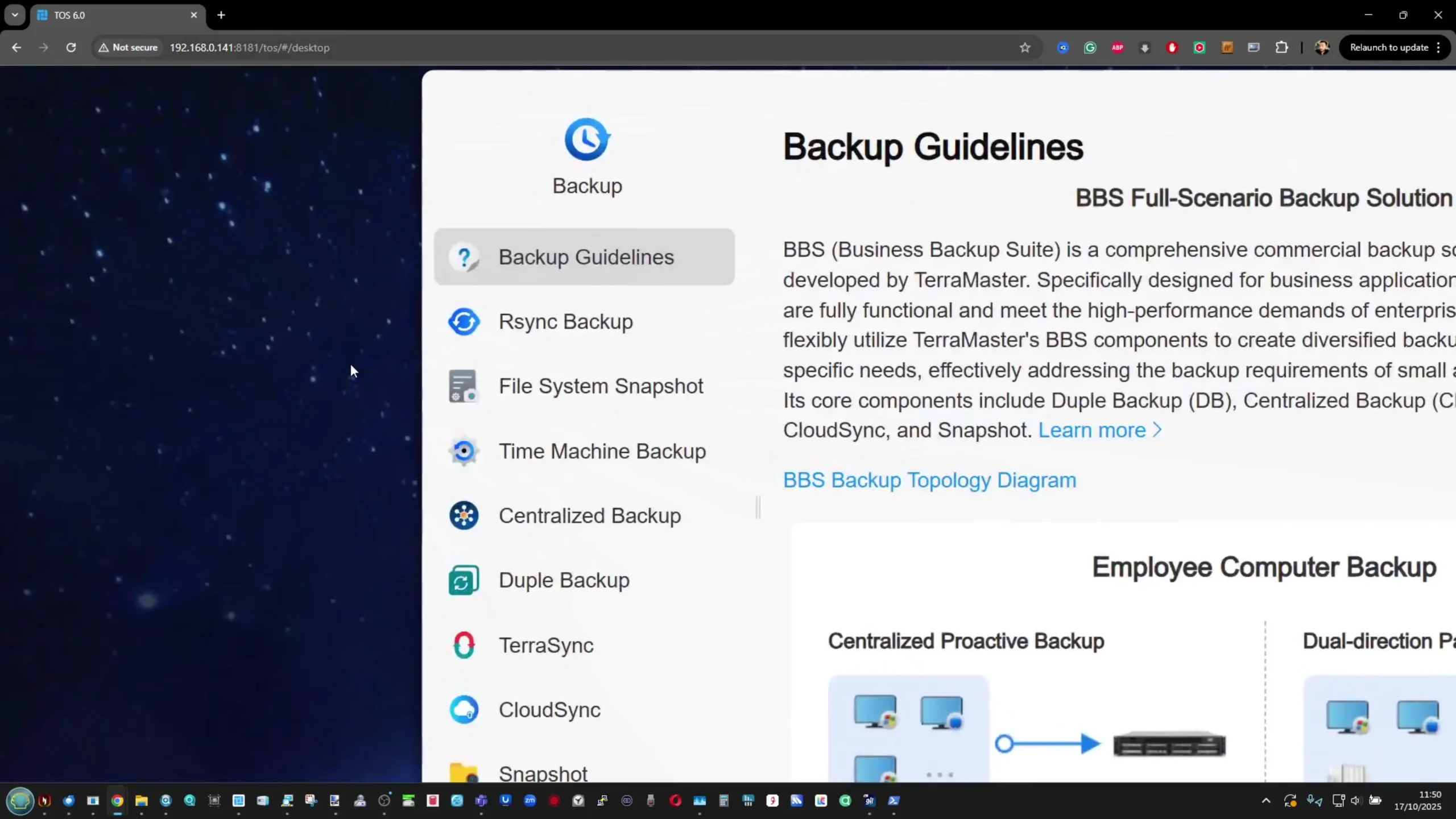 |
Beyond local storage, the device integrates directly with TerraMaster’s CloudSync service, which connects to providers like Google Drive, OneDrive, Dropbox, and Baidu Cloud. Hybrid storage configurations allow partial replication or tiered backup between the NAS and the cloud, offering an extra level of redundancy for professional workflows. External connectivity through USB 3.2 ports also supports direct backups to DAS enclosures or portable drives. Altogether, the F4-425 Plus’s design emphasizes efficient cooling, solid construction, and versatile storage architecture, making it a flexible foundation for both data-heavy projects and long-term digital archiving.
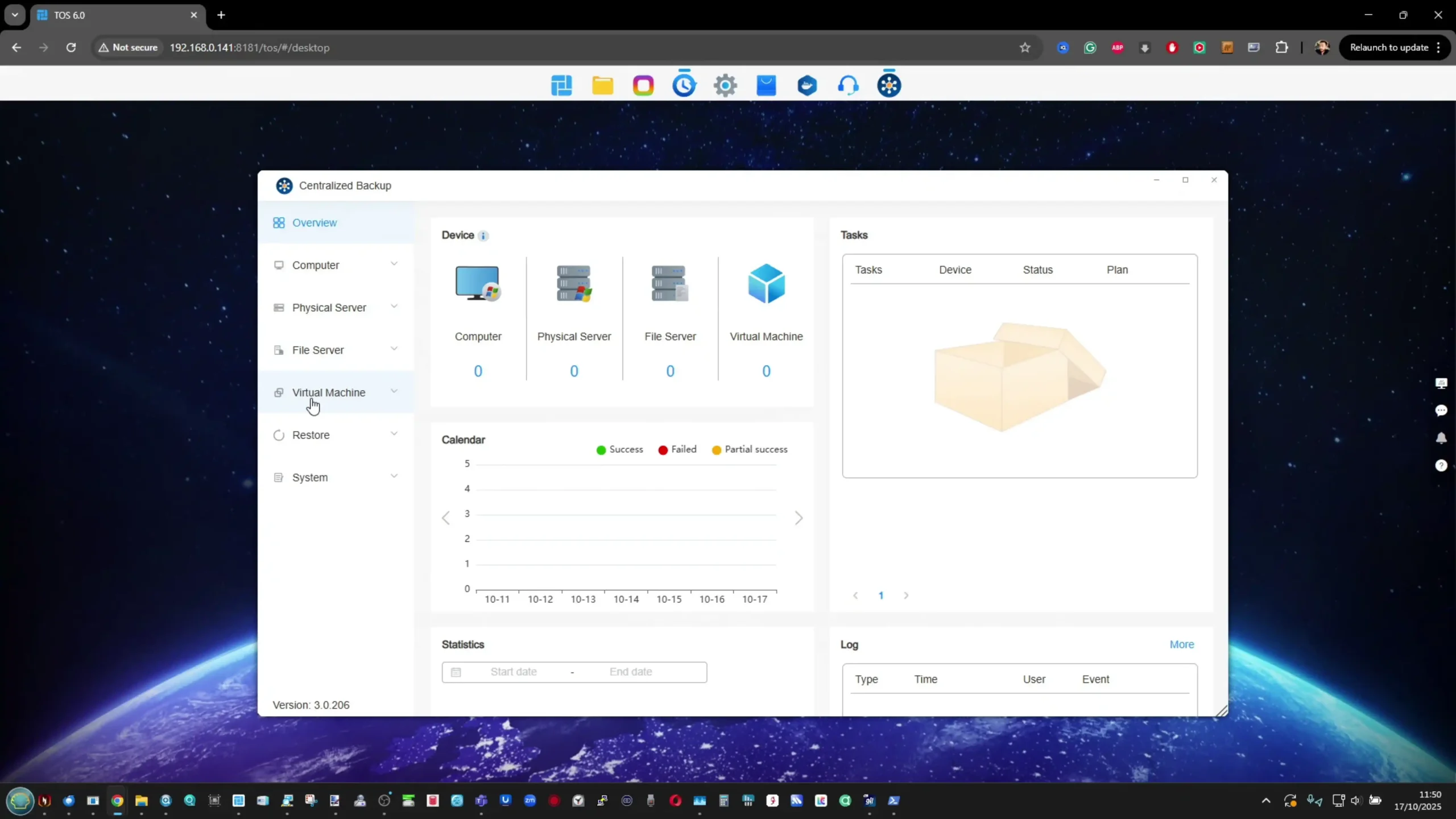 |
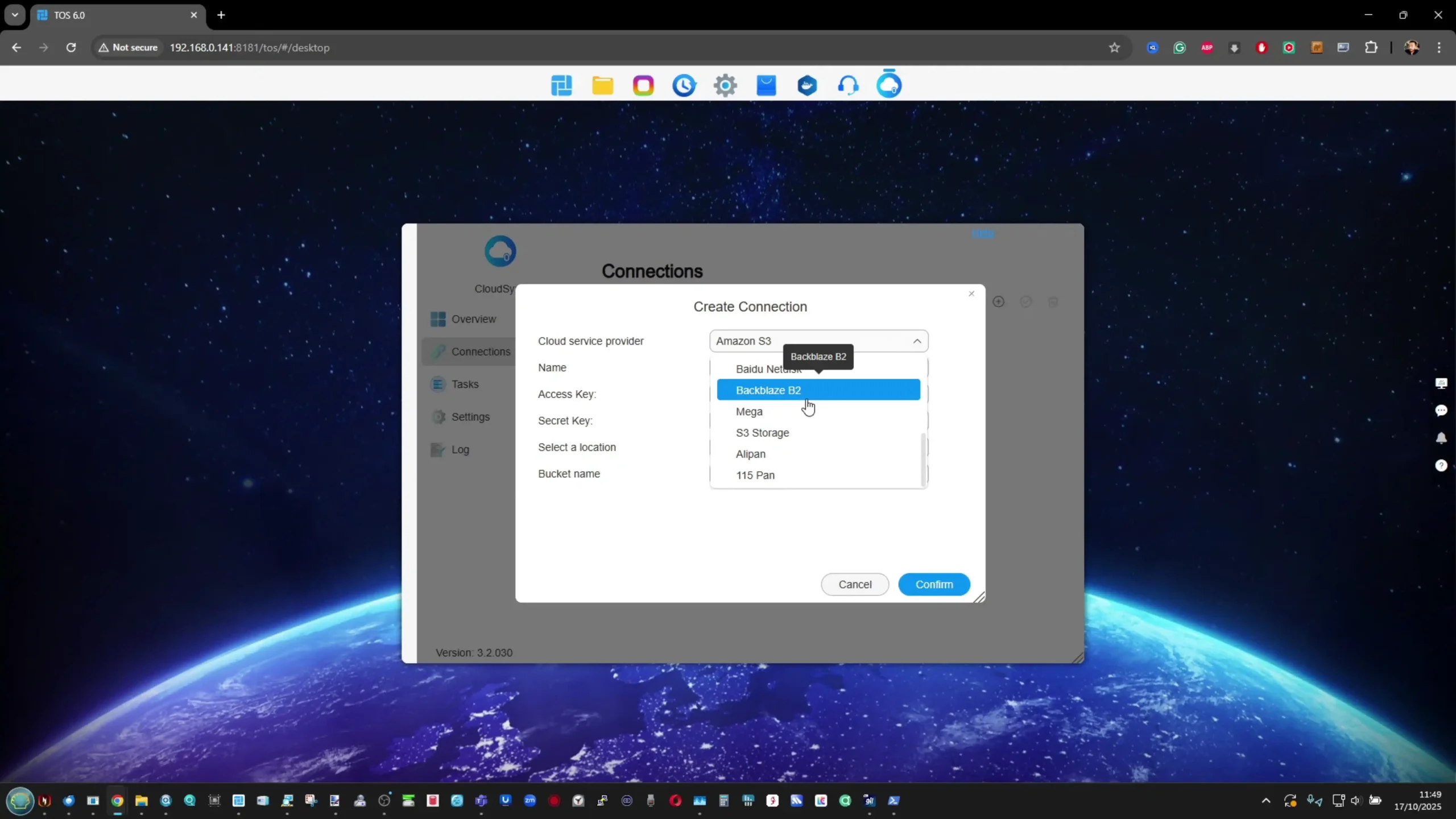 |
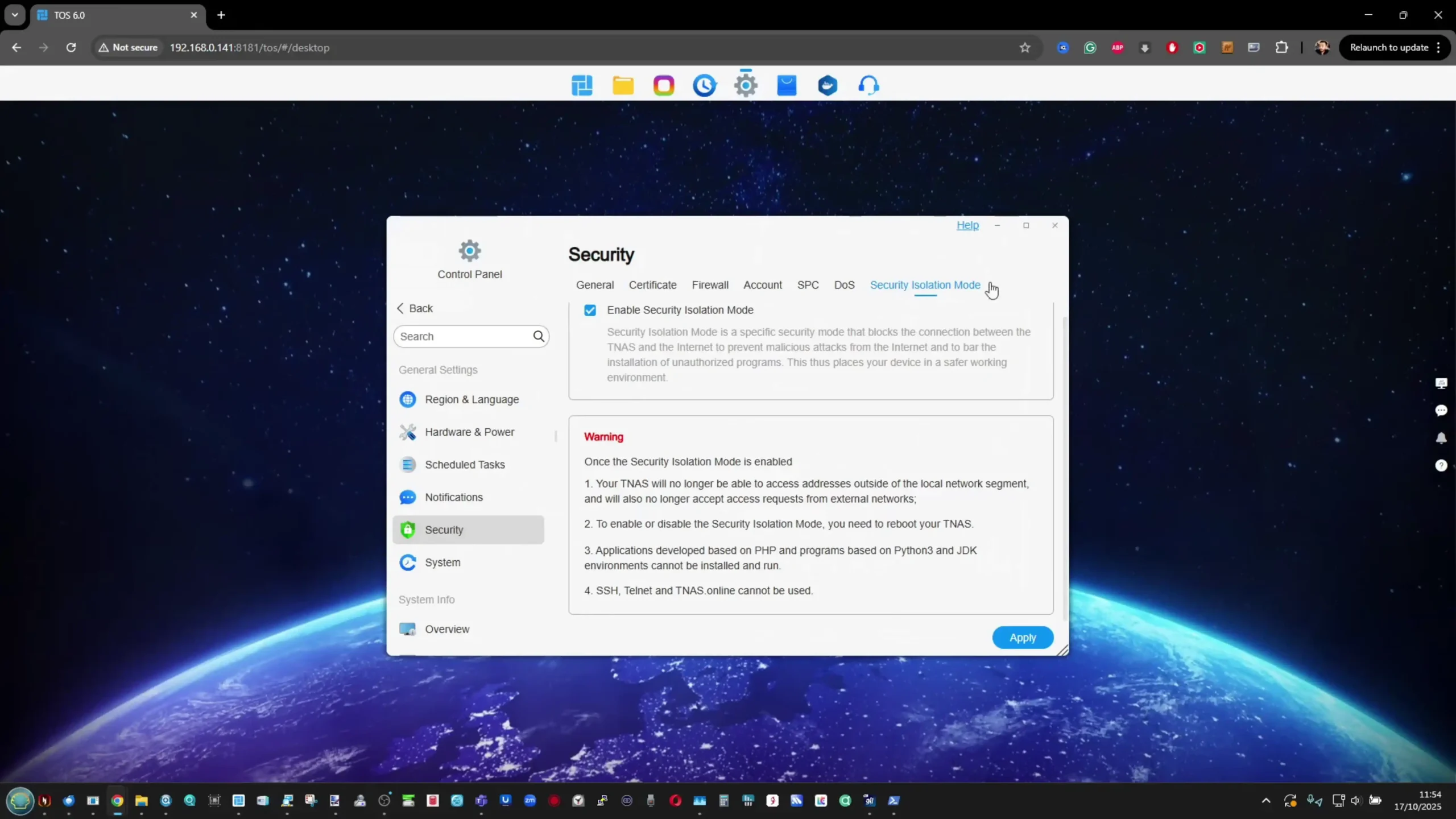 |
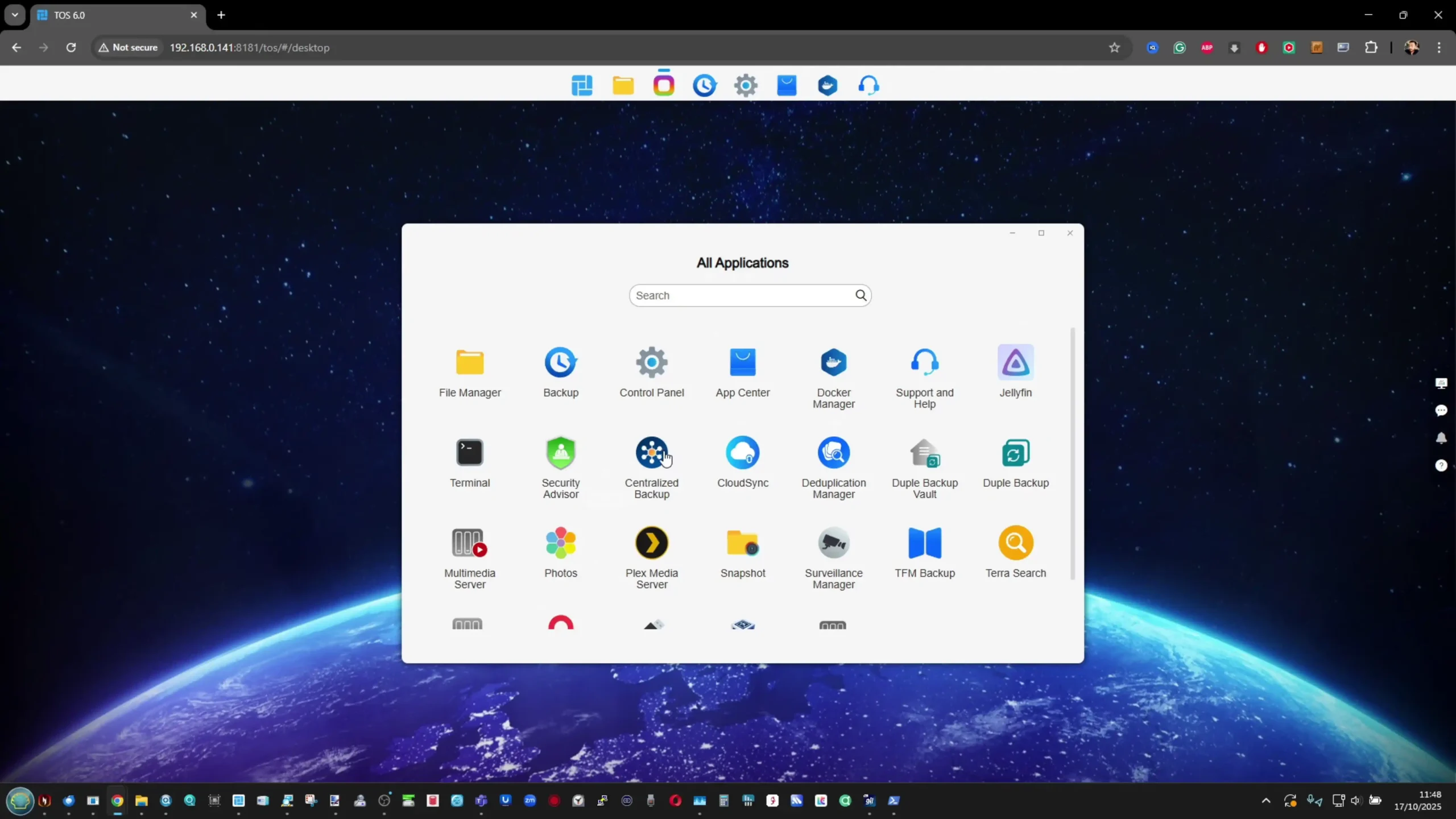 |
The Terramaster F4-425 PLUS NAS Review – Internal Hardware
Internally, the TerraMaster F4-425 Plus is structured around Intel’s N150 processor, a 4-core, 4-thread CPU from the Twin Lake generation. Built on a 6W TDP architecture, this chip delivers a significant efficiency advantage over the previous N5095-based systems while offering a higher burst clock of up to 3.6 GHz. The CPU integrates Intel UHD Graphics, allowing 4K hardware decoding for H.264, H.265, VC-1, and MPEG-4, which is particularly beneficial for Plex, Emby, or Jellyfin users who want native transcoding without GPU add-ons.
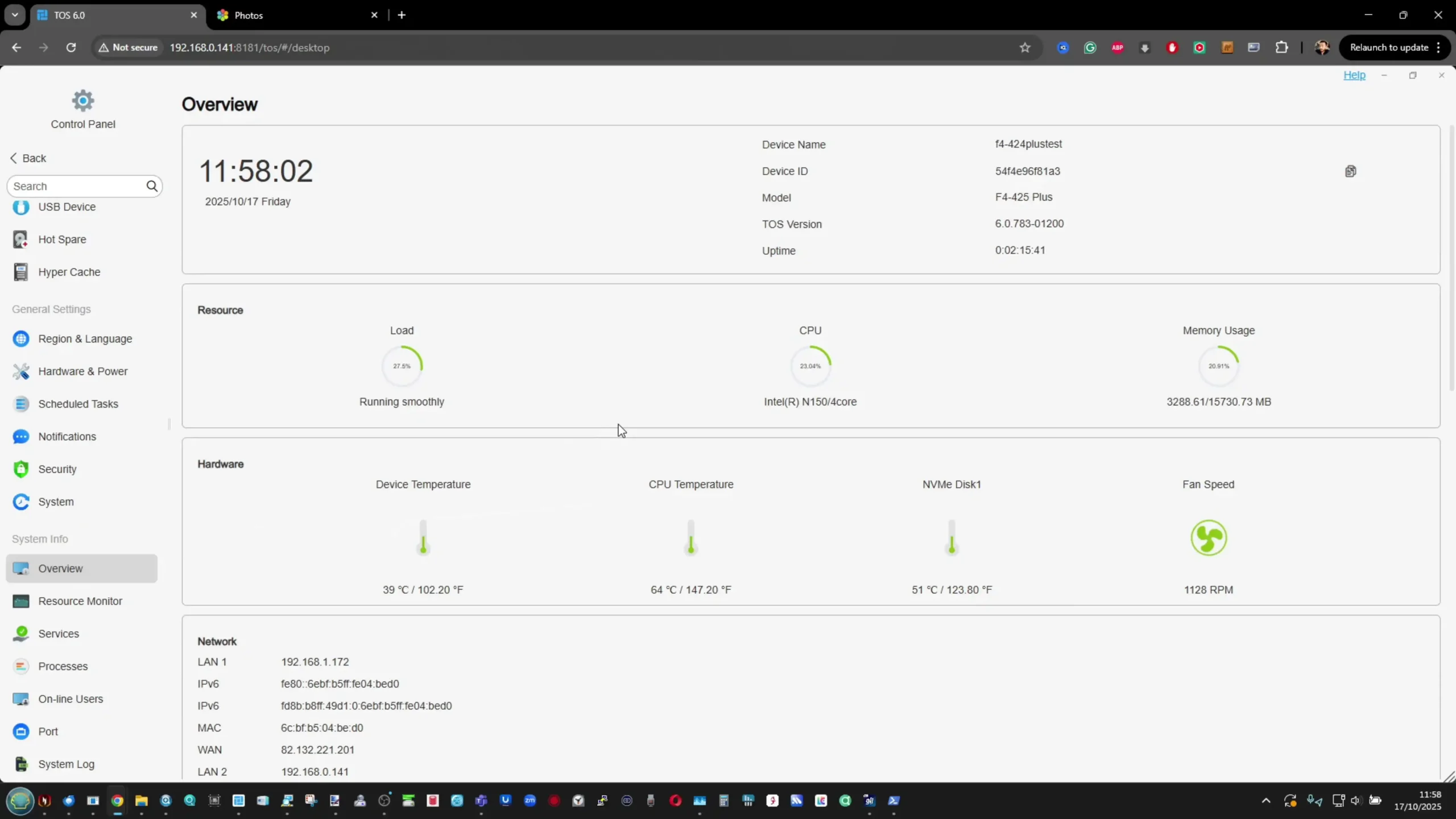
This combination makes the system viable not only as a file server but also as a local multimedia hub, capable of decoding and streaming 4K video at up to 60 frames per second. Despite being a low-power chip, its instruction set includes AES-NI hardware encryption, ensuring efficient data security without notable throughput loss when encryption is enabled.
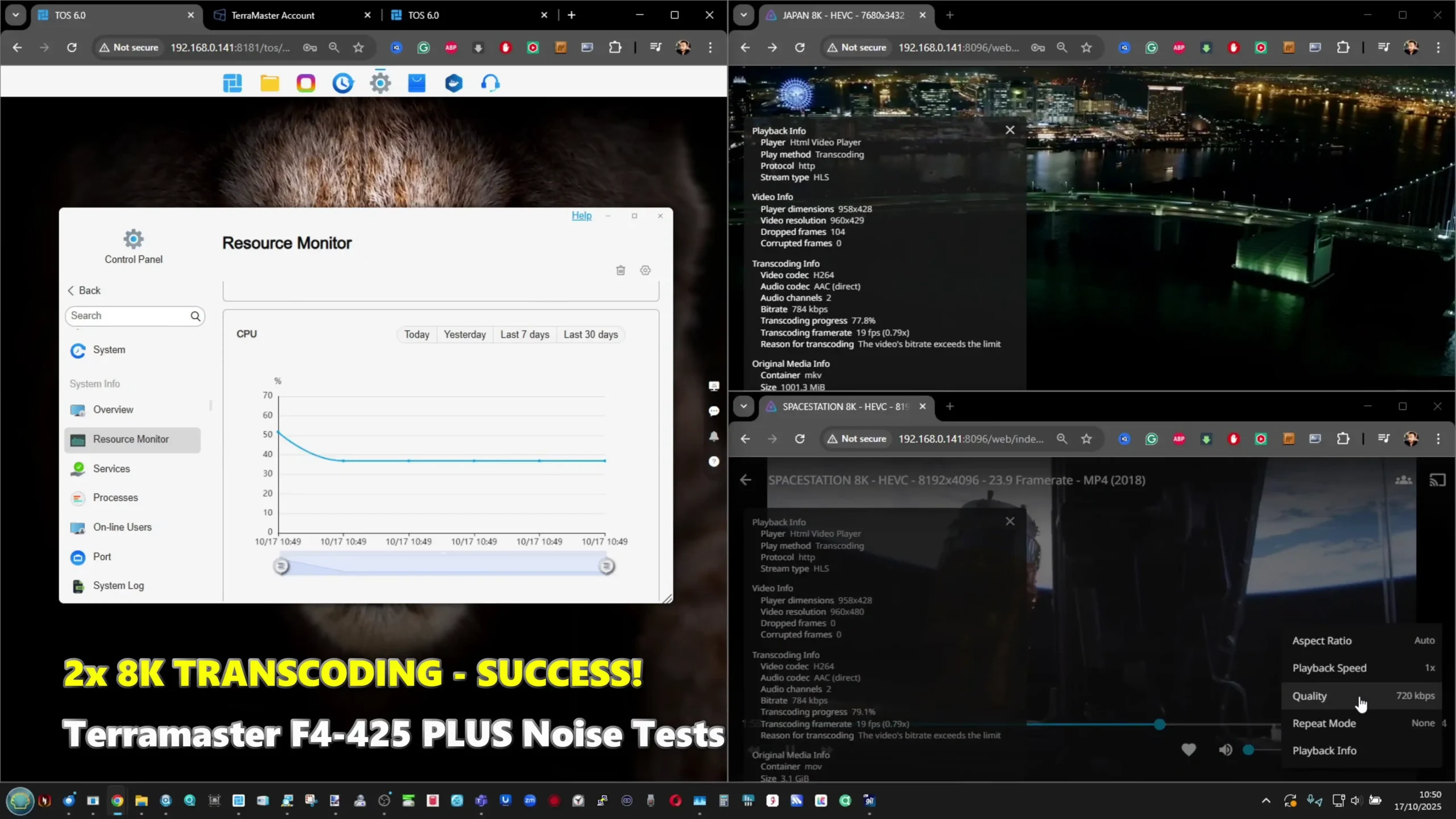
The system’s memory architecture uses a single DDR5 SO-DIMM slot, populated with a 16GB non-ECC module by default and expandable up to 32GB. The adoption of DDR5 over DDR4 marks a generational improvement in bandwidth and latency, leading to faster multitasking, smoother virtualization performance, and reduced overhead when handling multiple users or services. The memory module is non-ECC but benefits from on-die error correction at the hardware level, offering stability improvements over standard DDR4 implementations. This approach aligns with the unit’s target demographic of small offices, creators, and advanced home users who want server-grade responsiveness without enterprise complexity.
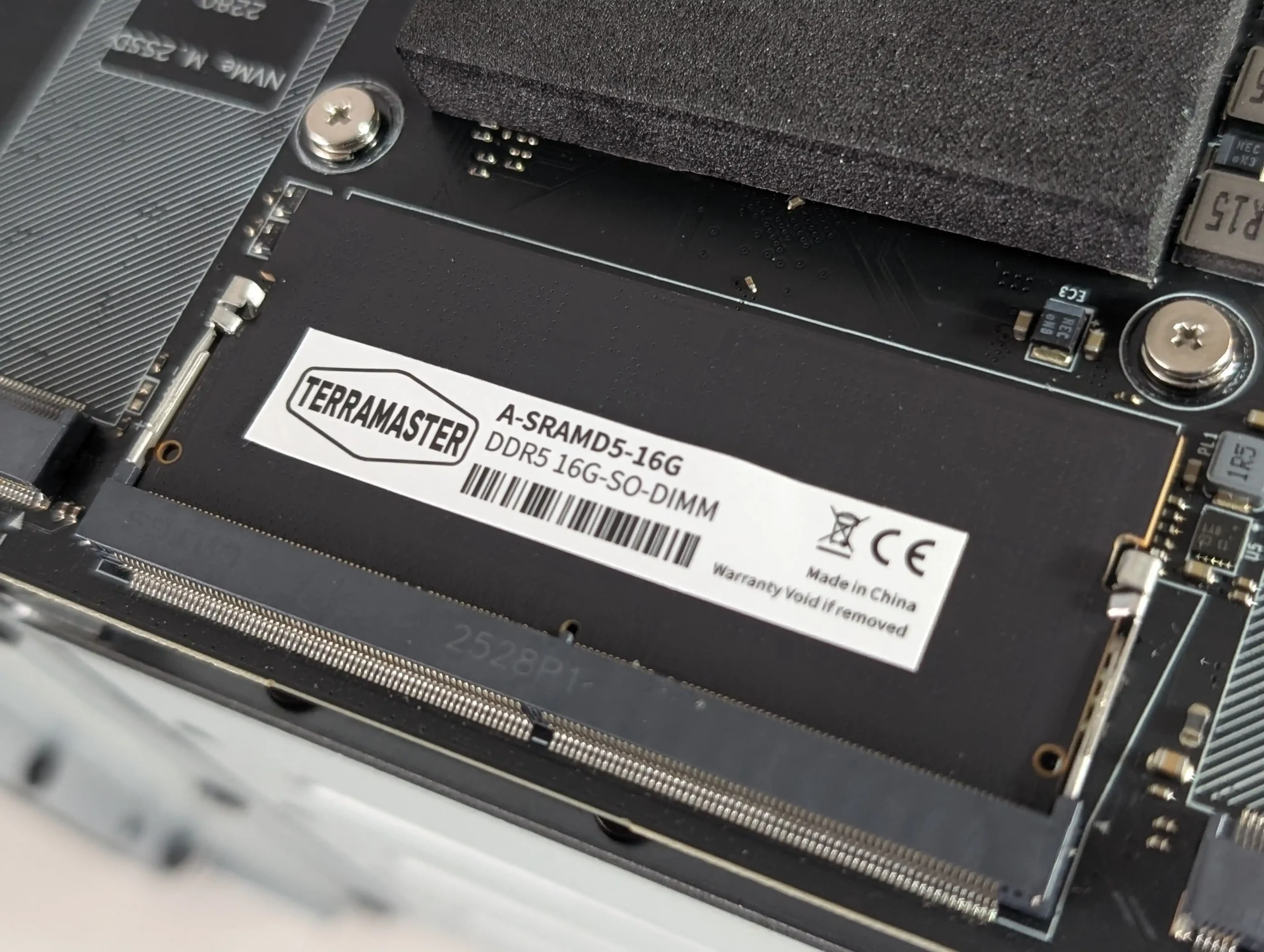
Storage connectivity within the system is distributed between four SATA III 6Gb/s interfaces managed by an ASMedia controller and three PCIe 3.0 x1 lanes dedicated to M.2 NVMe SSDs. This configuration ensures balanced throughput for simultaneous HDD and SSD activity. Internally, the layout is straightforward, providing easy access to both the memory slot and M.2 bays via the removable top panel. The power supply is a single 90W external brick, keeping internal temperatures lower and simplifying maintenance.
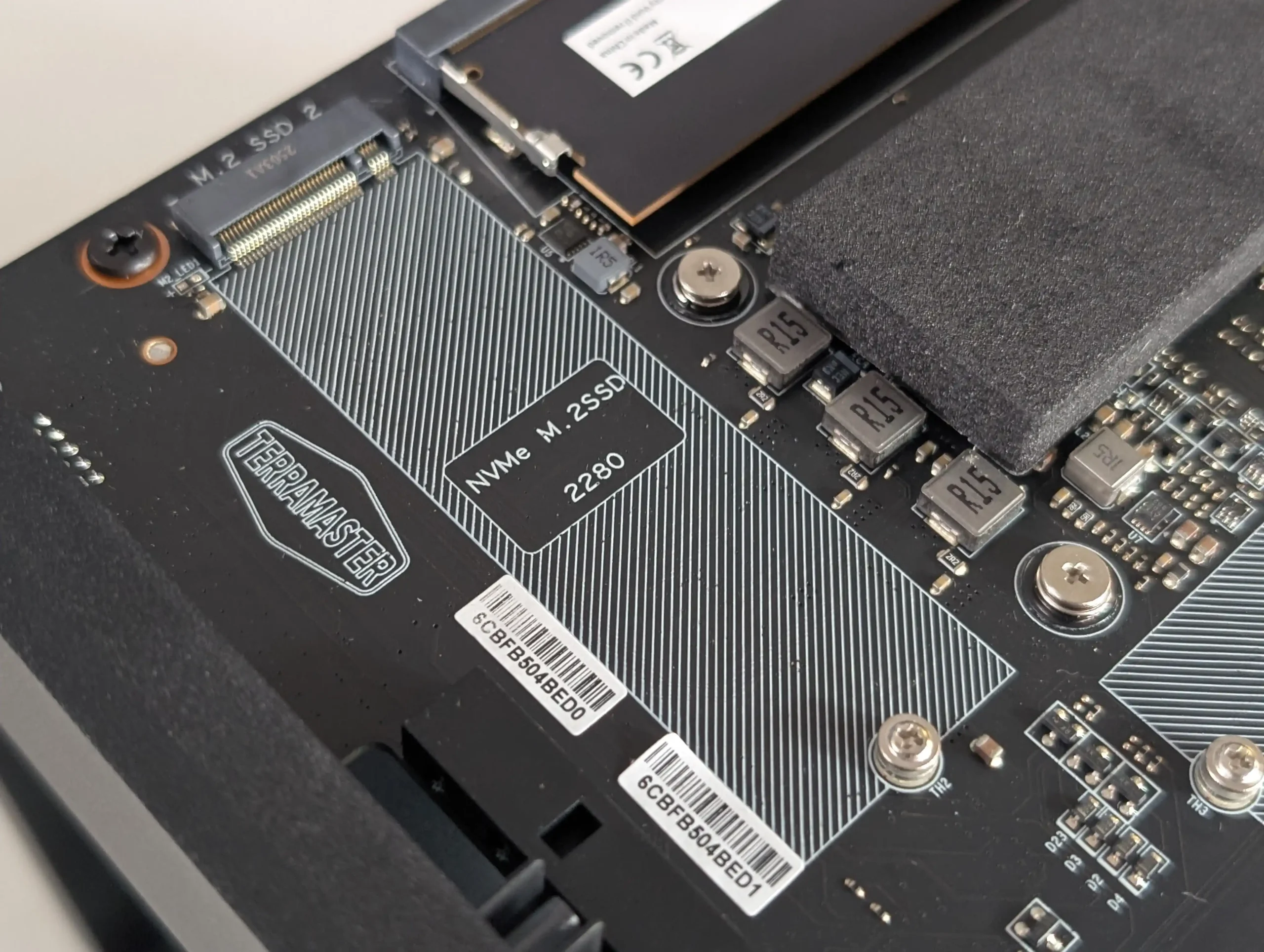
Together, the hardware configuration represents a thoughtful balance between efficiency, expandability, and performance, aimed at users who need consistent data access, multimedia capabilities, and reliable long-term operation without excess noise or heat.
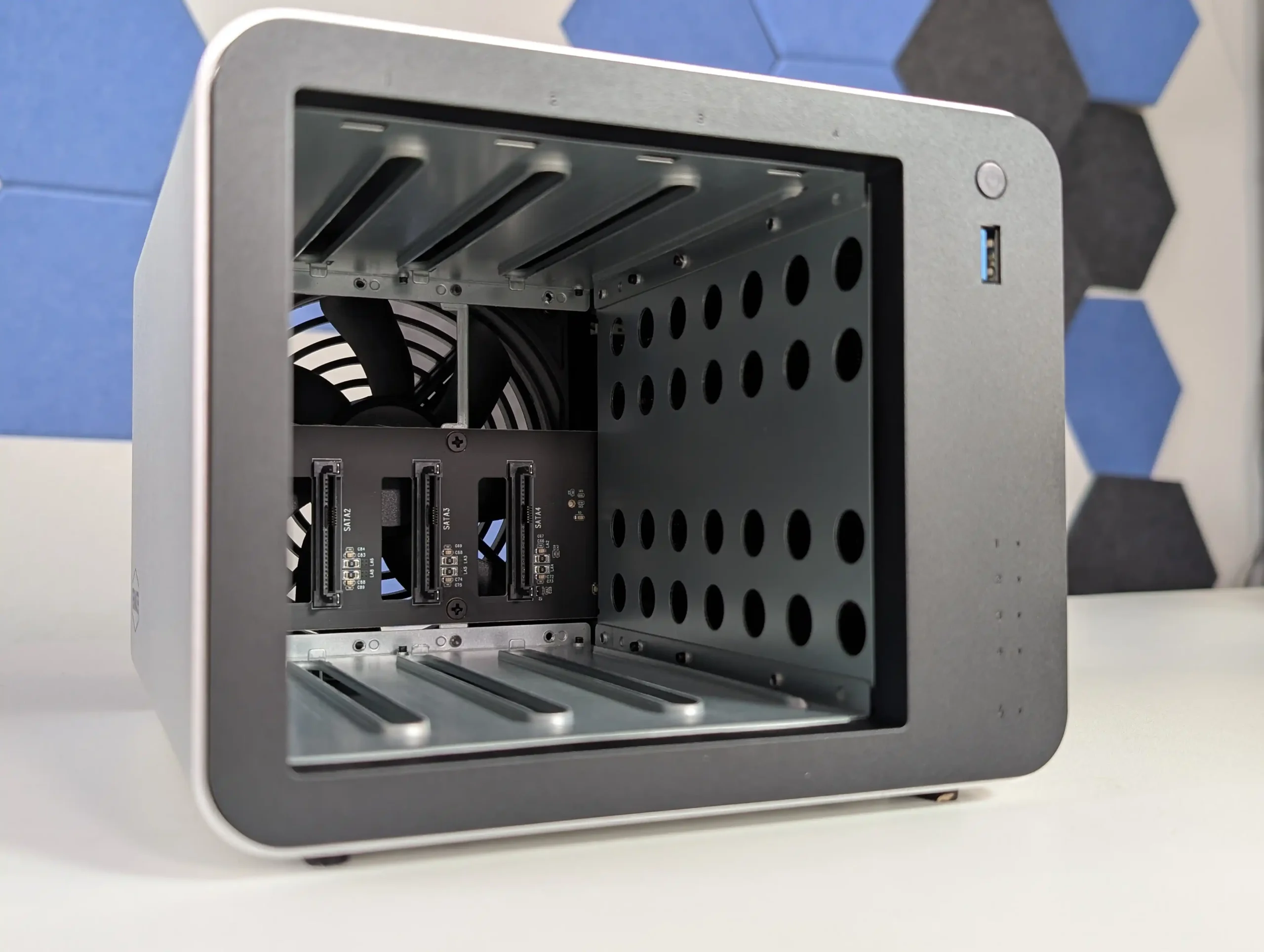
| Component | Details |
|---|---|
| Processor | Intel N150 Quad-Core (1.0 GHz base, up to 3.6 GHz burst) |
| Architecture | x86 64-bit, Intel Twin Lake |
| Hardware Encryption | AES-NI engine |
| Hardware Transcoding | H.264, H.265, VC-1, MPEG-4 up to 4K 60 FPS |
| Memory | 16 GB DDR5 non-ECC SO-DIMM (1x16GB preinstalled) |
| Max Memory | 32 GB DDR5 |
| Drive Bays | 4 x 3.5″/2.5″ SATA 6Gb/s |
| NVMe Slots | 3 x M.2 2280 PCIe 3.0 x1 |
| Max Storage | 120 TB (HDDs) + 24 TB (SSDs) = up to 144 TB combined |
| RAID Options | TRAID, TRAID+, Single, JBOD, RAID 0/1/5/6/10 |
| File Systems | Btrfs, EXT4 (internal); NTFS, FAT32, HFS+, Btrfs (external) |
| Power Supply | 90W external adapter |
| Cooling | 1 x 120mm smart fan (adjustable) |
| Noise Level | 20.9 dB(A) in idle |
| Dimensions (H x W x D) | 150 x 181 x 219 mm |
| Weight | 2.9 kg (net) |
| Operating Temperature | 0°C to 40°C |
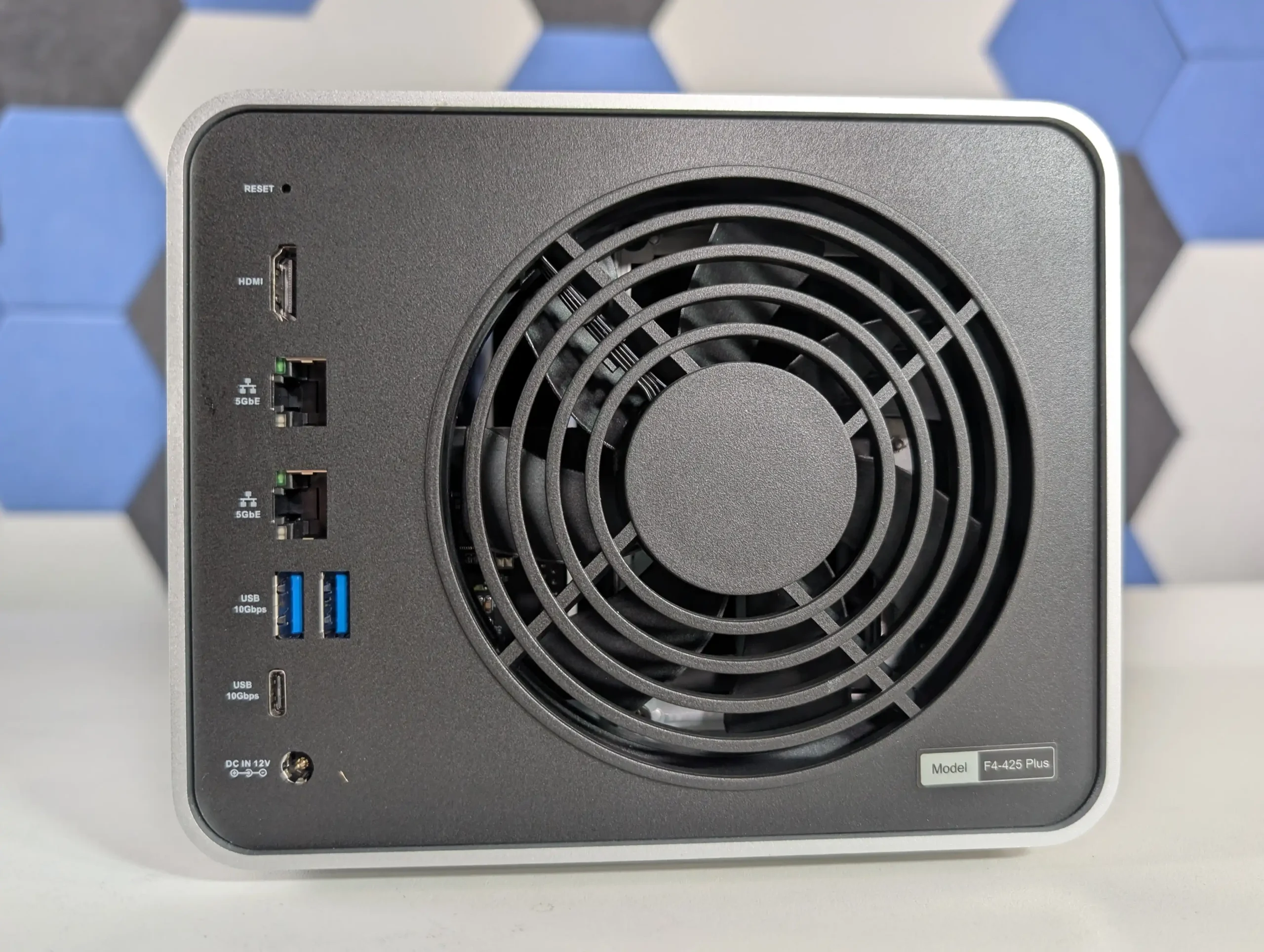
The Terramaster F4-425 PLUS NAS Review – Ports and Connections
The TerraMaster F4-425 Plus offers a broad range of connectivity designed to meet both high-speed networking and general expansion needs. On the rear panel, two 5GbE RJ-45 network ports serve as the central performance feature. These are among the first dual 5GbE implementations in a mid-tier NAS, and each port operates through its own dedicated PCIe 3.0 x1 lane, avoiding bandwidth contention. In testing, each port achieved full theoretical throughput, confirming proper lane allocation. Users can enable link aggregation or SMB multichannel for multi-user workloads, although saturating both ports simultaneously requires fast SSD or hybrid storage configurations. These ports support IPv4/IPv6, VLAN tagging, link aggregation, and Wake-on-LAN, making the system suitable for both small office environments and direct workstation connections.
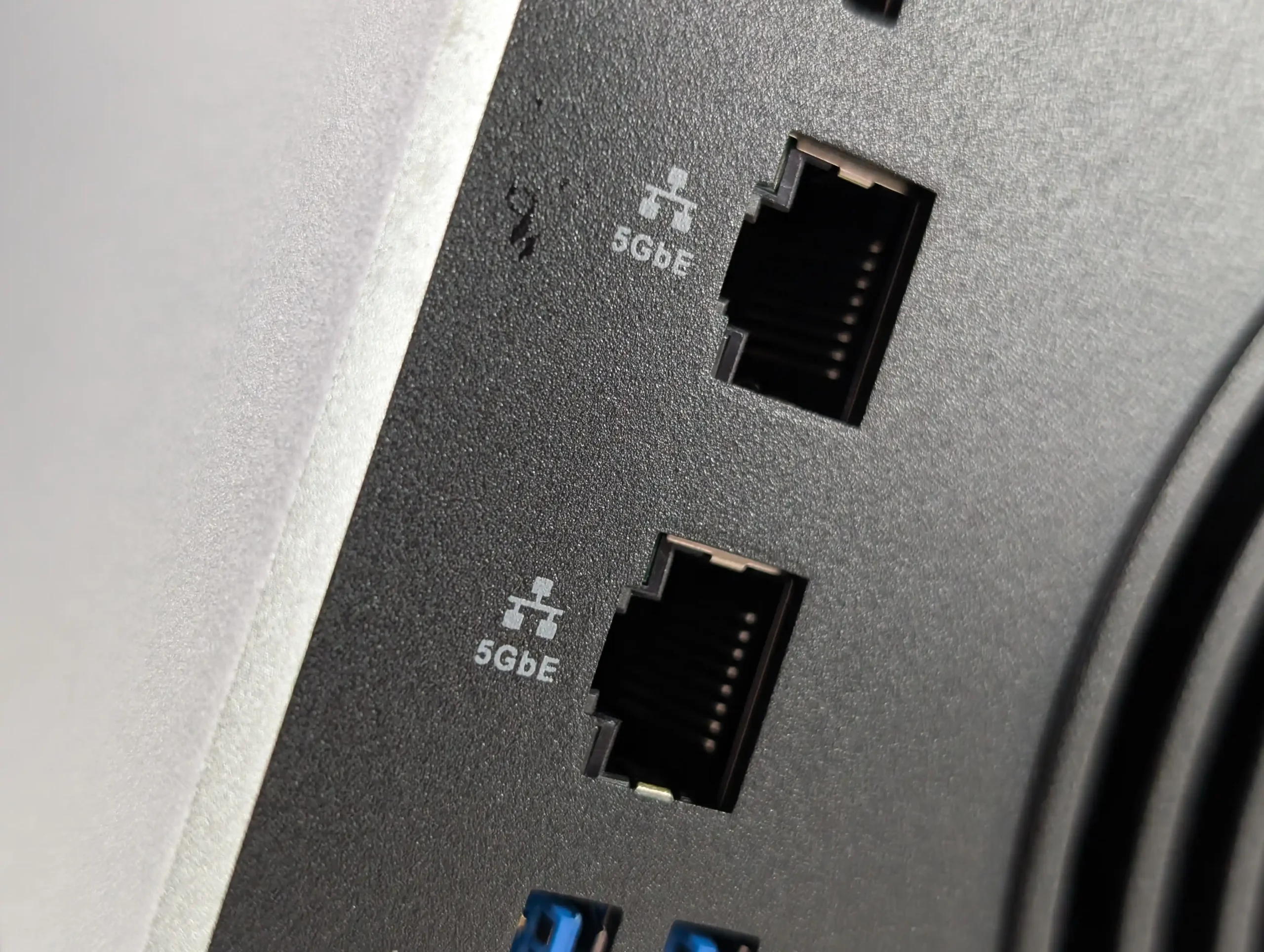
Complementing the network interfaces, the F4-425 Plus includes four USB 3.2 ports: three Type-A and one Type-C, all operating at 10Gbps. These ports can handle external DAS enclosures, UPS devices, or high-capacity backup drives. The inclusion of a front-mounted USB port improves convenience for ad hoc backups or quick file transfers, addressing a long-standing omission in earlier TerraMaster models. Additionally, an HDMI 2.1 output is positioned on the rear, though its practical use remains limited within TOS, which lacks a native display interface. It may, however, prove useful for third-party operating systems such as Unraid or TrueNAS, where direct console access or local media playback is desired.
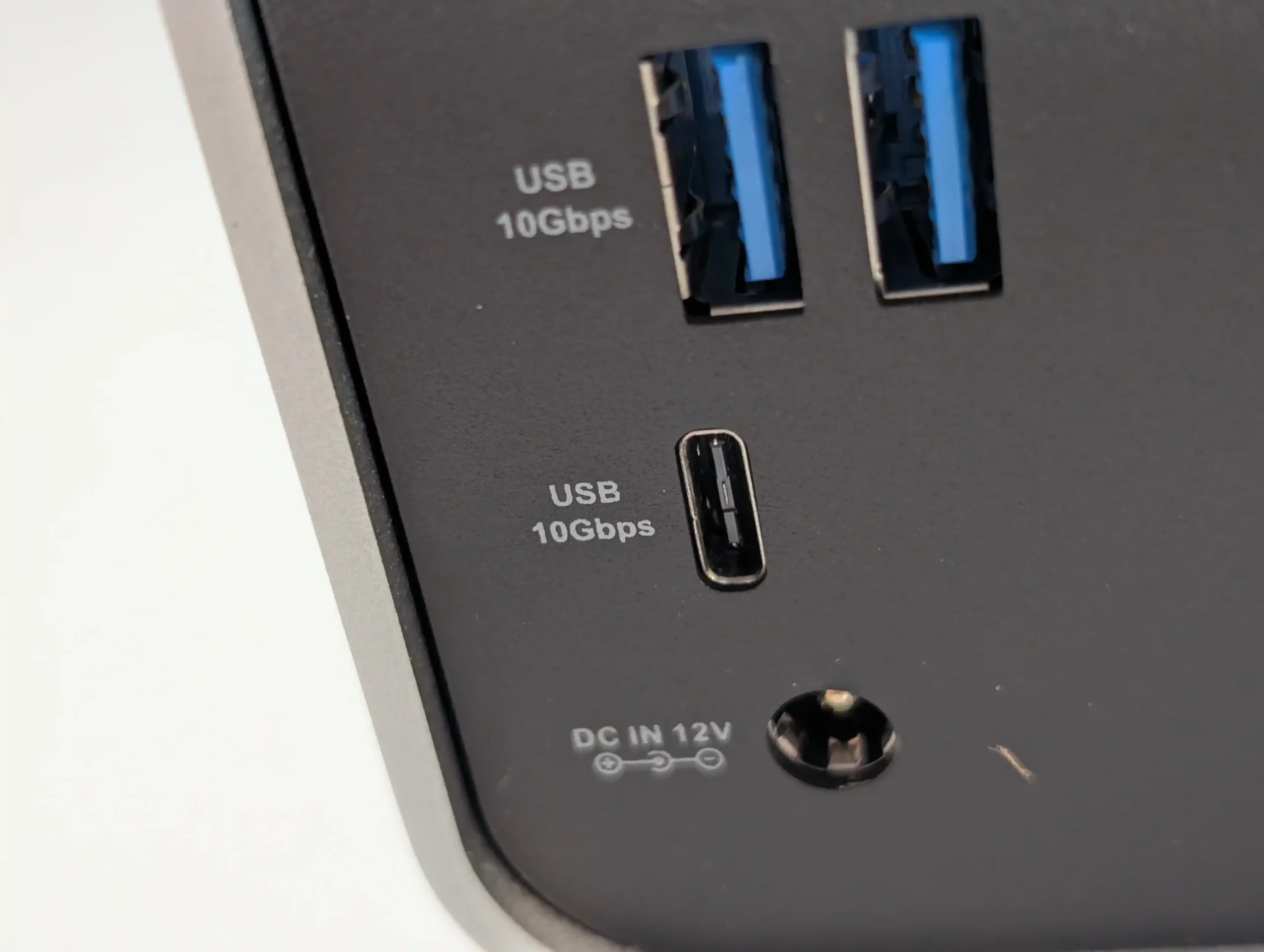
Overall, the port layout is clean and efficient, optimized for straightforward cable management. The system’s single large fan sits adjacent to the networking array, allowing for effective airflow without excessive cable obstruction. Power is supplied through a standard barrel connector linked to an external 90W adapter, which helps reduce internal heat buildup. Though it lacks built-in 10GbE or PCIe expansion, the dual 5GbE setup provides more than enough bandwidth for its class, especially when paired with NVMe caching. Users can also connect the NAS to TerraMaster’s USB-based DAS units for storage expansion or off-site replication, offering flexibility without compromising portability or noise levels.
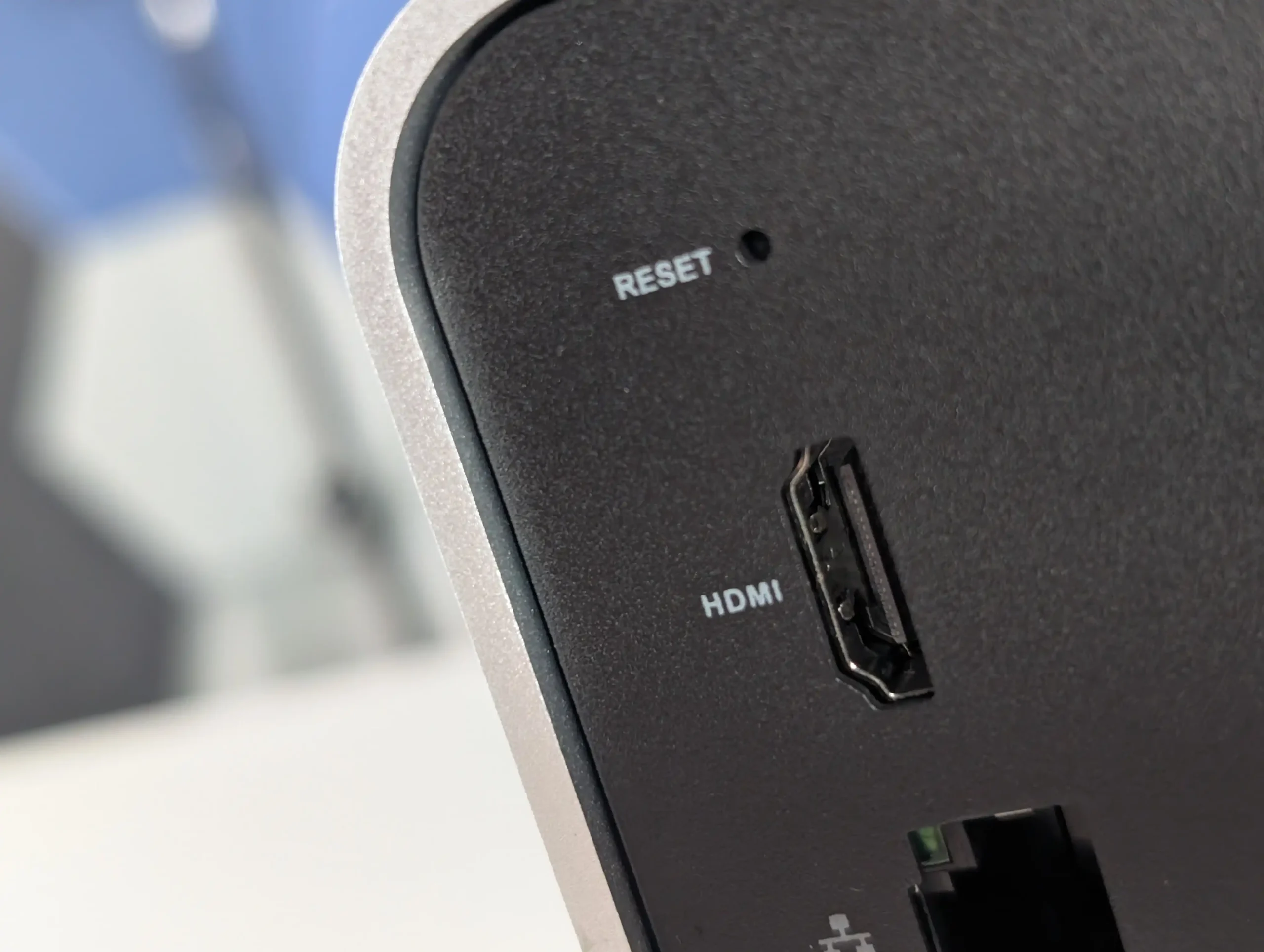
| Connection Type | Quantity / Type | Details |
|---|---|---|
| Network Ports | 2 × 5GbE RJ-45 | Independent PCIe 3.0 x1 lanes, Link Aggregation and SMB Multichannel supported |
| USB Ports | 3 × USB 3.2 Type-A, 1 × USB 3.2 Type-C | 10Gbps transfer rate, supports external DAS, UPS, and peripheral devices |
| HDMI Output | 1 × HDMI 2.1 | Up to 4K 60Hz, limited TOS functionality, usable under third-party OS |
| Power Input | 1 × DC-in (90W adapter) | External PSU to minimize chassis heat |
| Cooling | 1 × 120mm Smart Fan | Adjustable speed profiles, rear-mounted |
| Expansion Options | USB DAS expansion | Supports TerraMaster DAS units for external scaling |
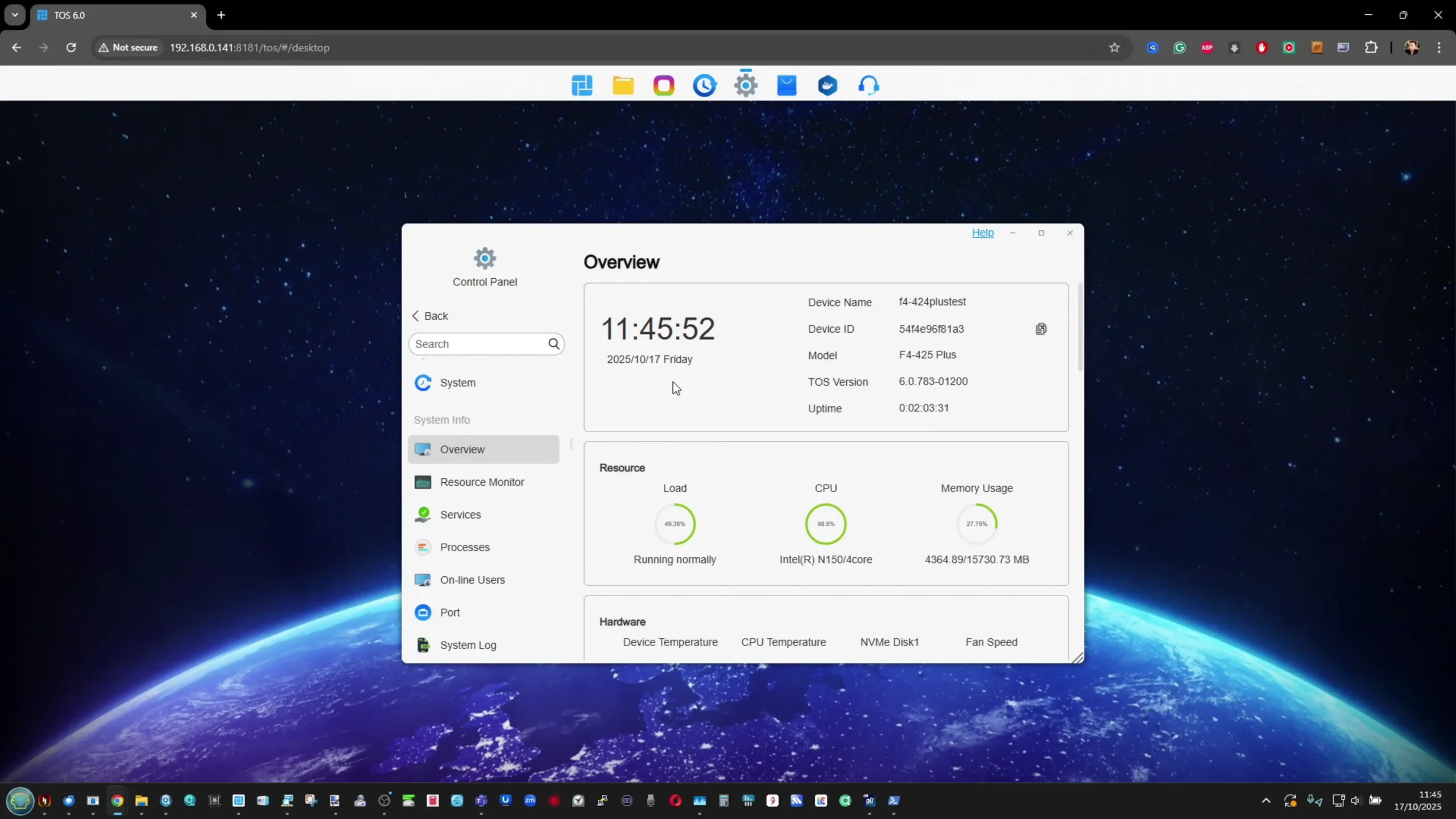
The Terramaster F4-425 PLUS NAS Review – Tests, Noise, Heat and Power Consumption
Performance testing on the TerraMaster F4-425 Plus showed that the system comfortably meets its advertised speed class, particularly when networked over a single 5GbE connection. Using four Toshiba MG-series 7200 RPM enterprise hard drives configured in RAID 5, the system achieved full saturation of one 5GbE port during both AJA and ATTO benchmark tests, reaching consistent read and write speeds around 500 to 520 MB/s. When tested with mixed media files totaling 50.5 GB, it completed the transfer in approximately 3 minutes and 45 seconds, equating to an average throughput of about 224 MB/s.
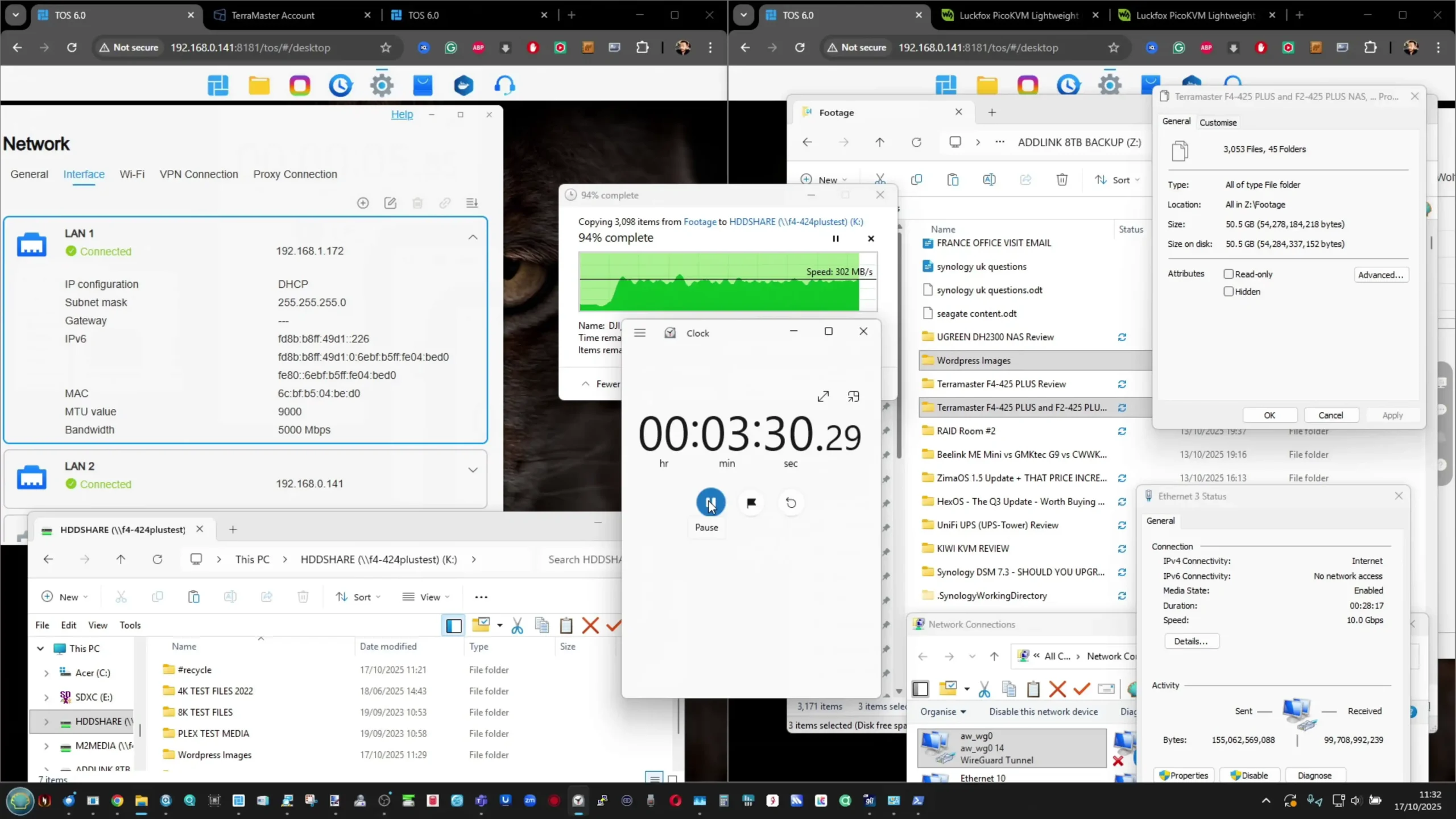
This is a strong result for a mechanical-drive setup, reflecting efficient caching and balanced SATA bandwidth. SMB Multichannel and link aggregation are supported, though the CPU’s available PCIe lanes limit simultaneous dual-port saturation. Even so, the system handles multiple concurrent transfers and backups without a noticeable decline in throughput.
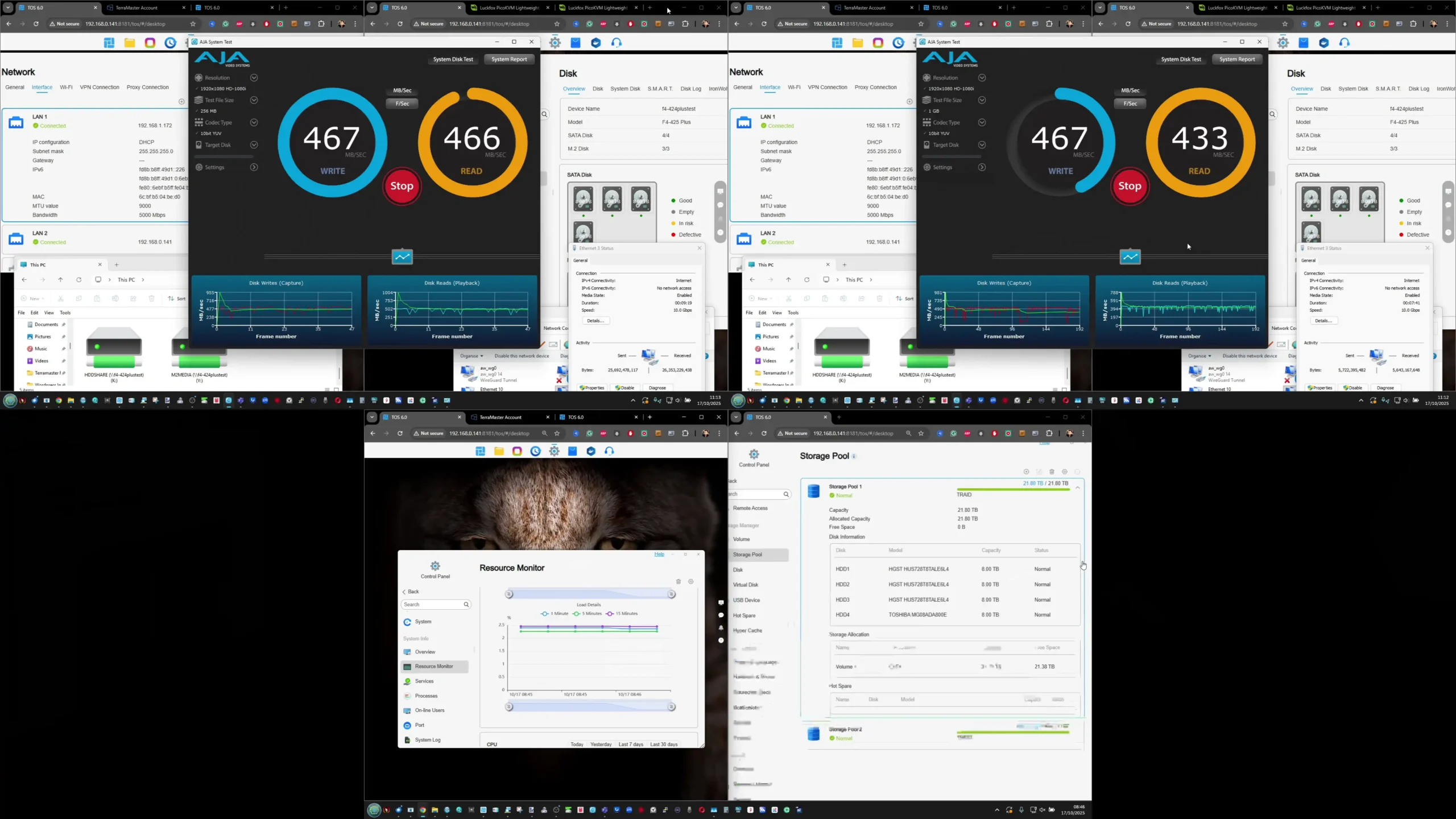
Testing with NVMe SSDs improved overall responsiveness considerably. The three M.2 2280 PCIe 3.0 x1 slots each sustained sequential transfer rates between 800 and 900 MB/s, allowing the NAS to maintain a high level of random IOPS for metadata-heavy workloads. When used as cache devices, these drives accelerated small-file transfers and application access times, especially when paired with the system’s 16GB of DDR5 memory.
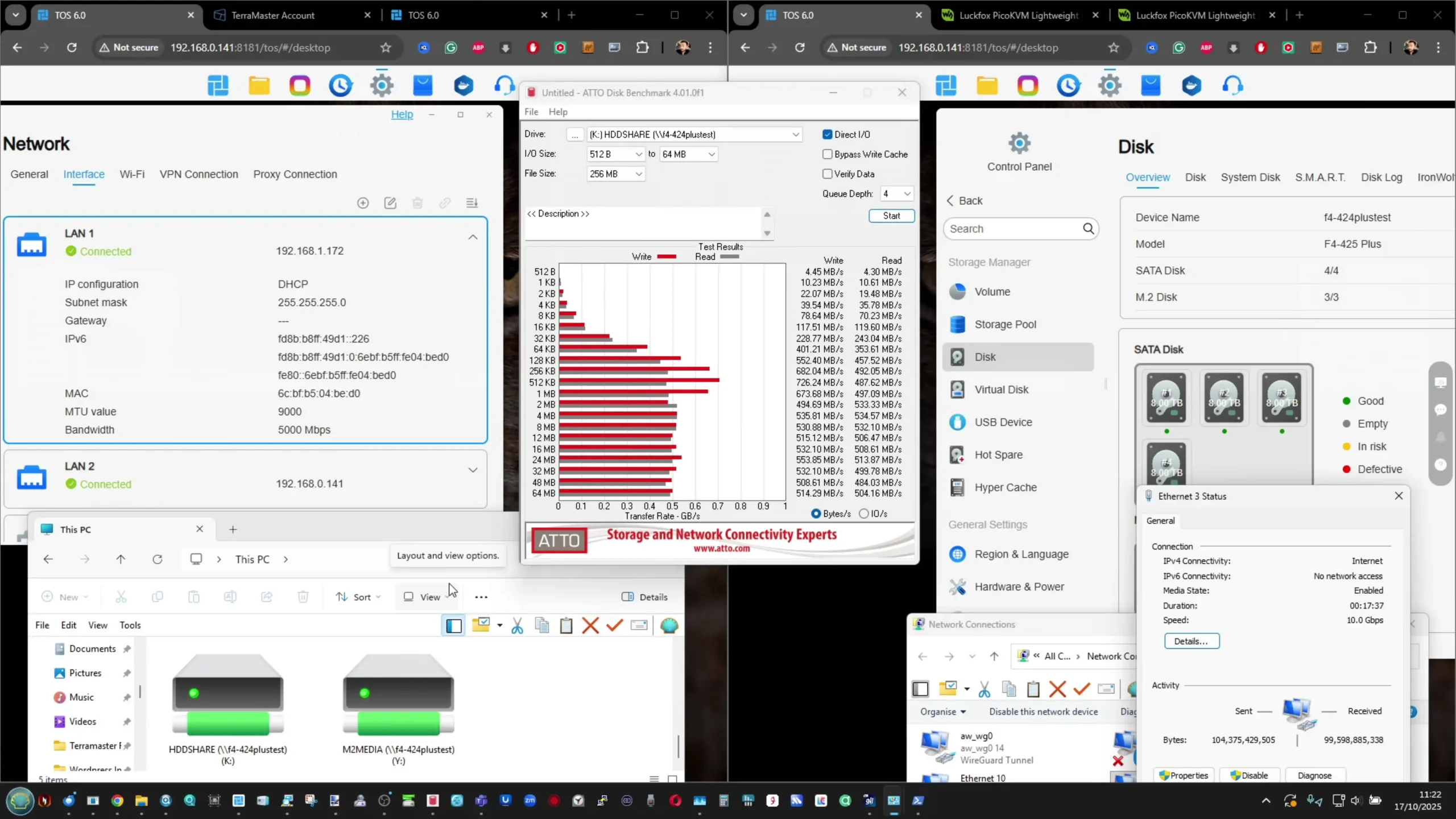
TerraMaster’s TOS 6 supports flexible use of these drives, enabling independent storage pools or hybrid cache layers, depending on the task. In sustained transfers over SMB and iSCSI, the system achieved write speeds close to 950 MB/s and reads near 1020 MB/s when using SSD-based arrays, validating the advantage of dual 5GbE interfaces for all-flash or mixed-tier environments.
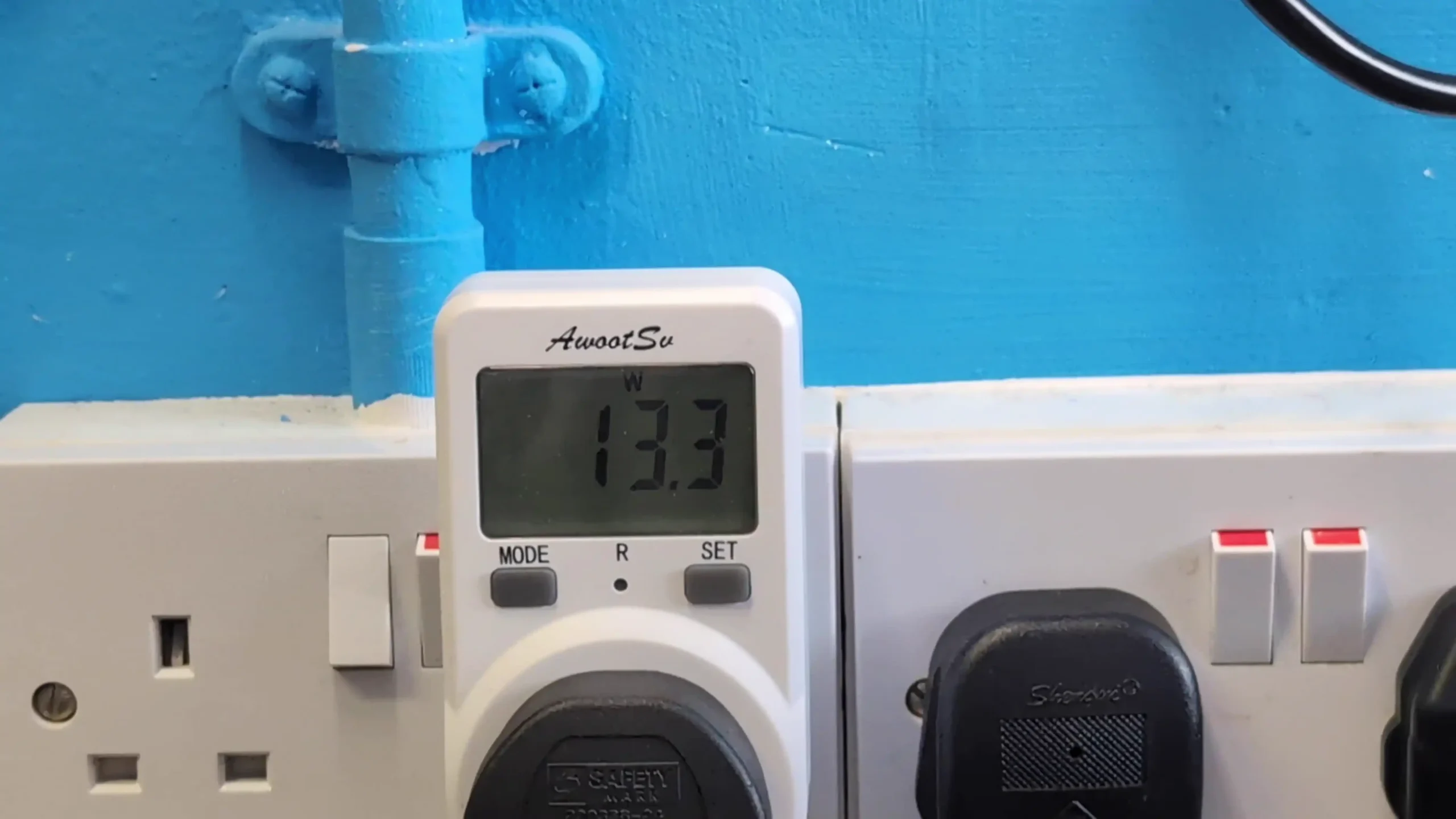 |
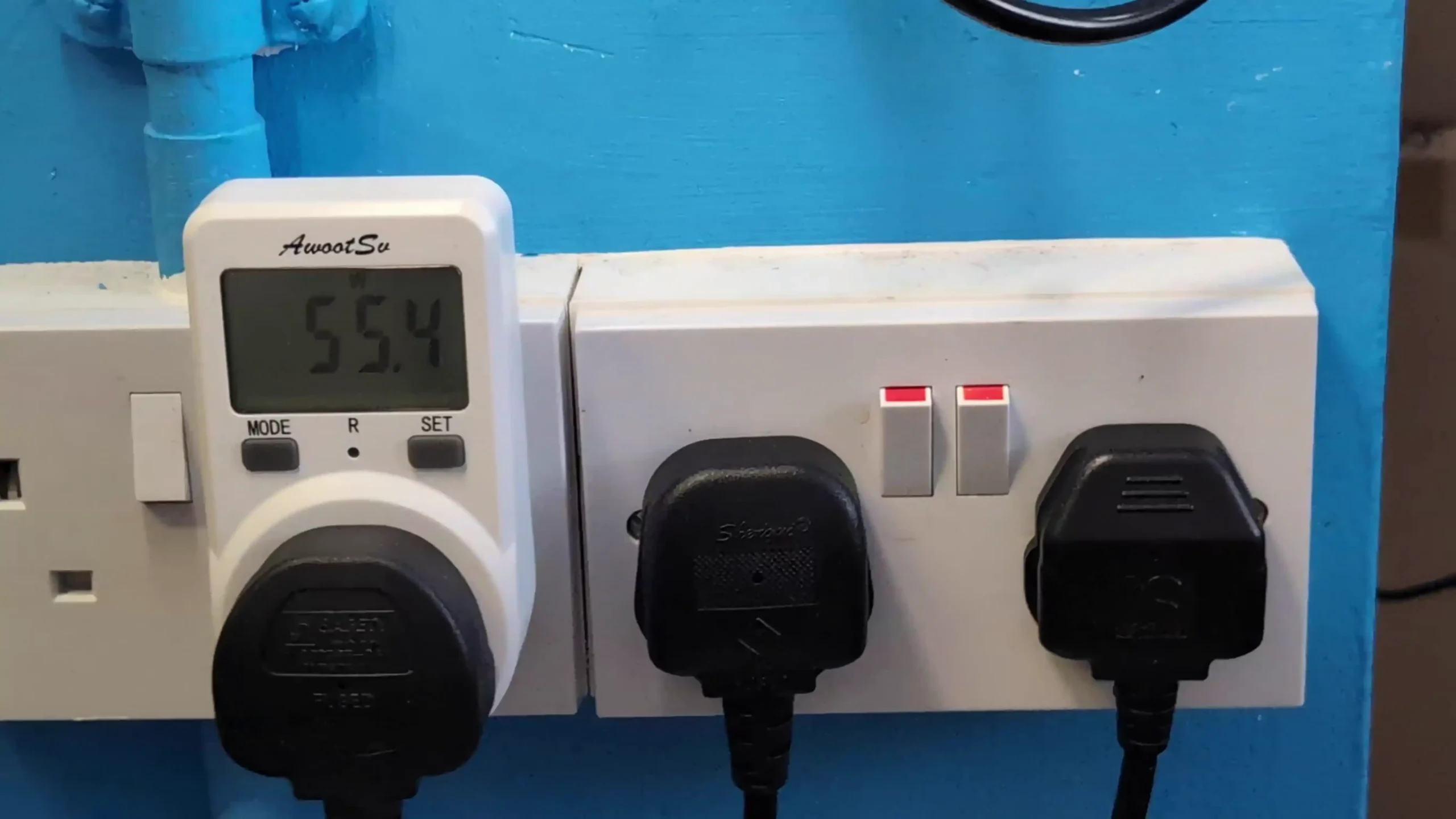 |
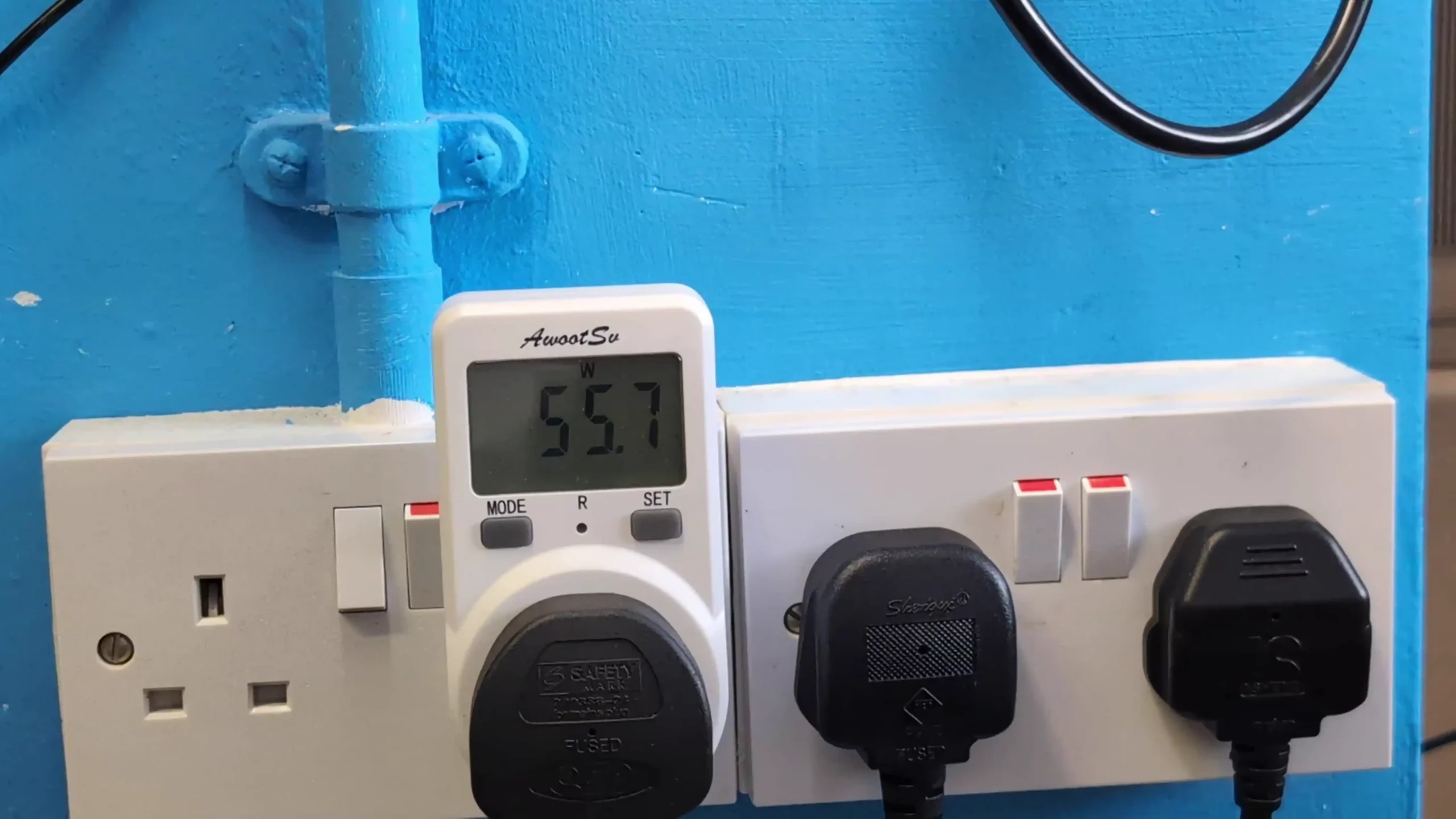 |
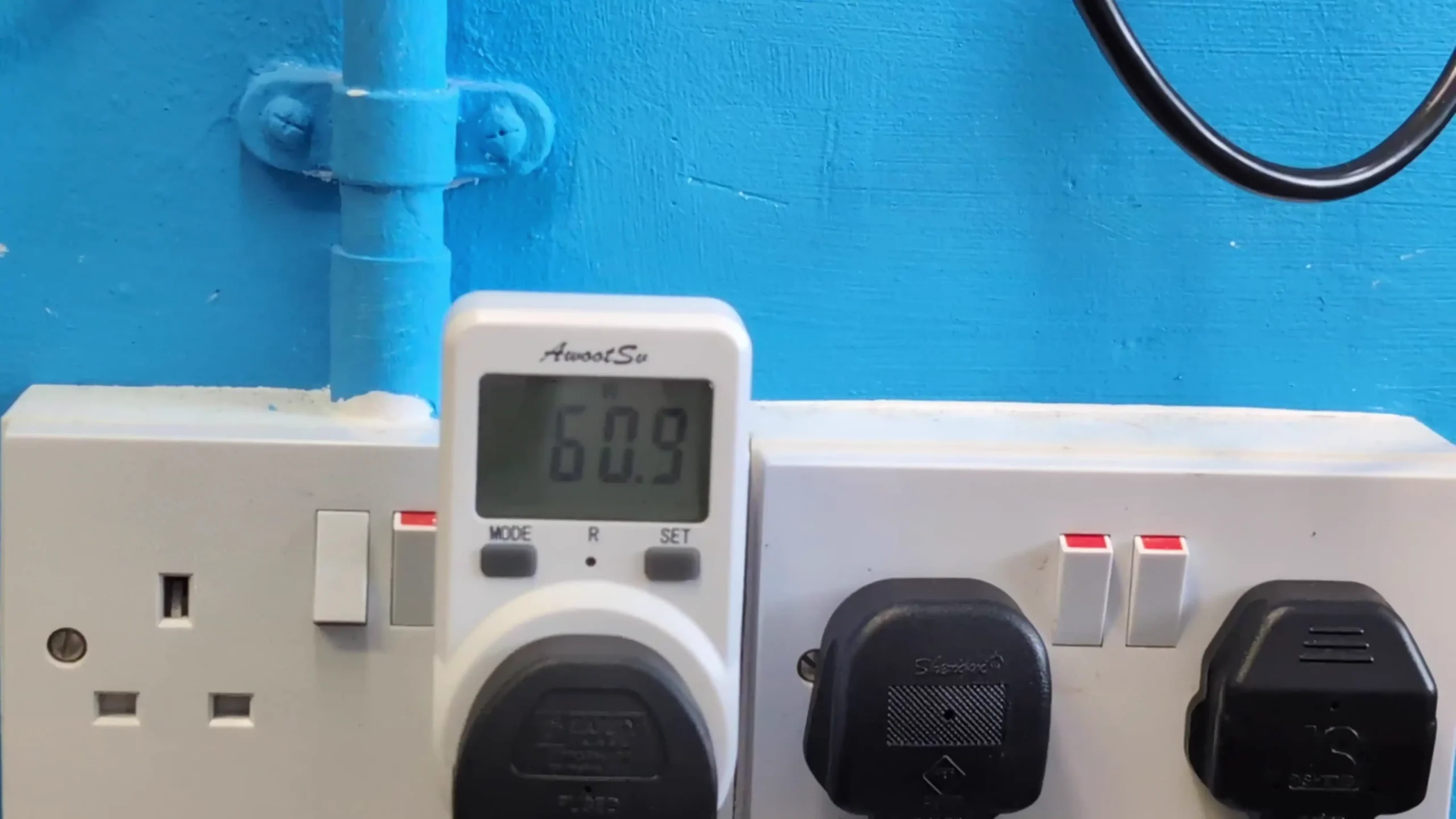 |
Power consumption during operation remained modest, aligning with the platform’s efficient design. With no hard drives installed and three SSDs active, idle draw measured around 13.3 watts. Adding four 7200 RPM HDDs increased idle power to 55 watts and full-load consumption to roughly 61–63 watts under concurrent read/write activity. These figures indicate a well-balanced design that prioritizes power efficiency without restricting performance. Fan speed settings affect both thermals and acoustics predictably: in low-speed mode, the NAS operated near 33 dB(A), while mid and high-speed profiles raised that figure to 37 and 39 dB(A) respectively. During heavy disk operations, readings peaked briefly at around 43 dB(A), which is reasonable given the metal chassis and high-RPM drives used in testing.
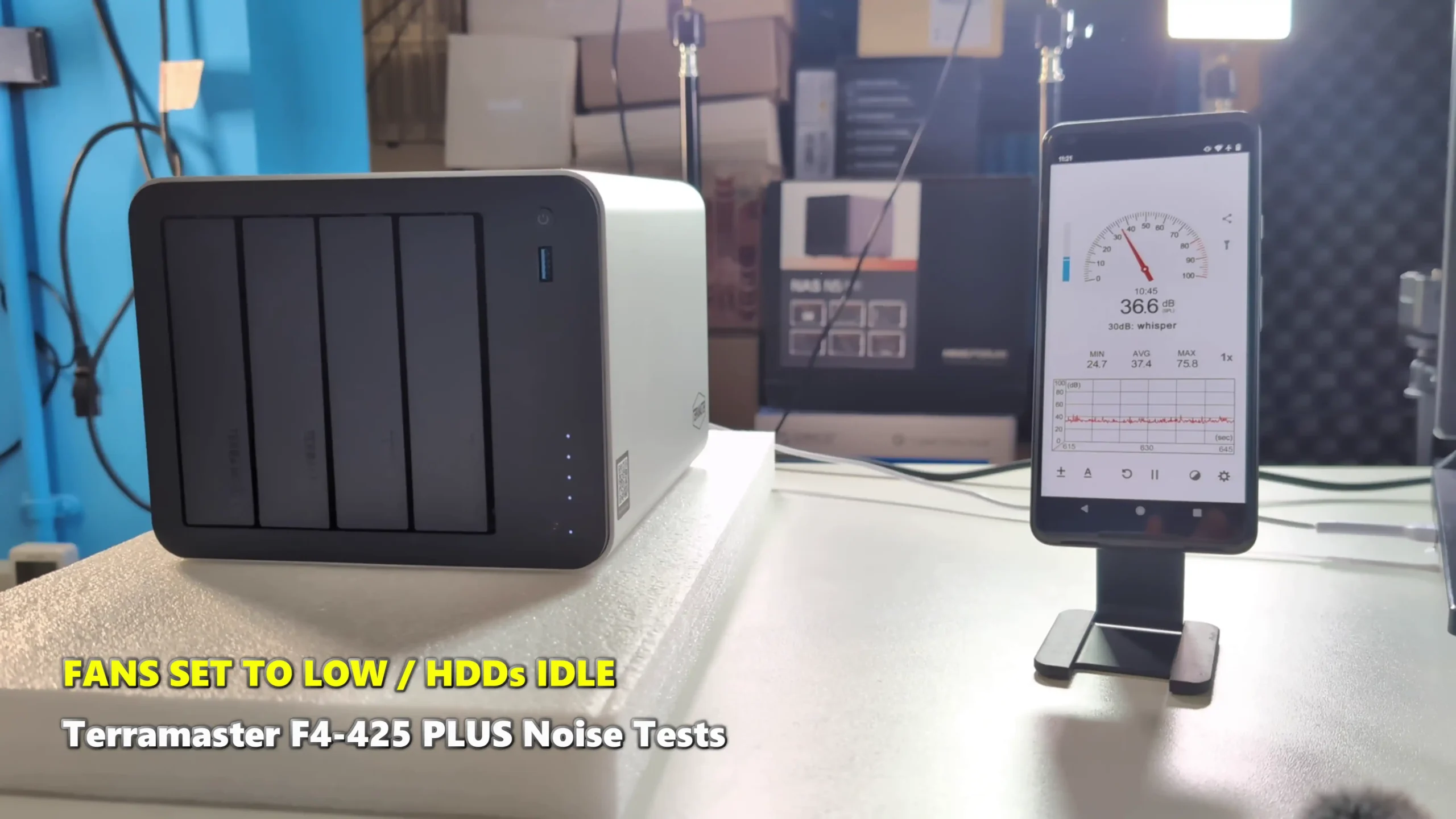 |
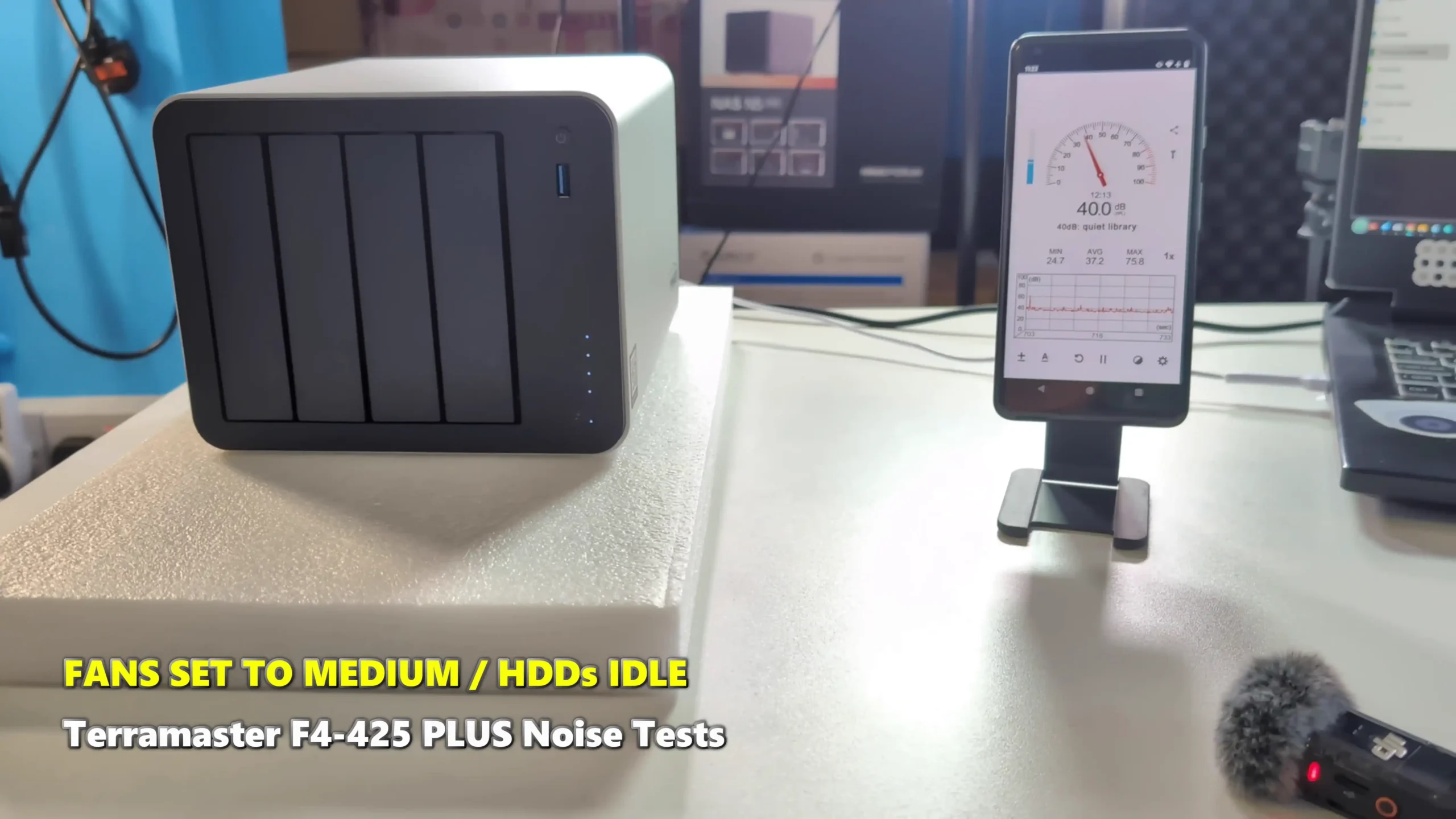 |
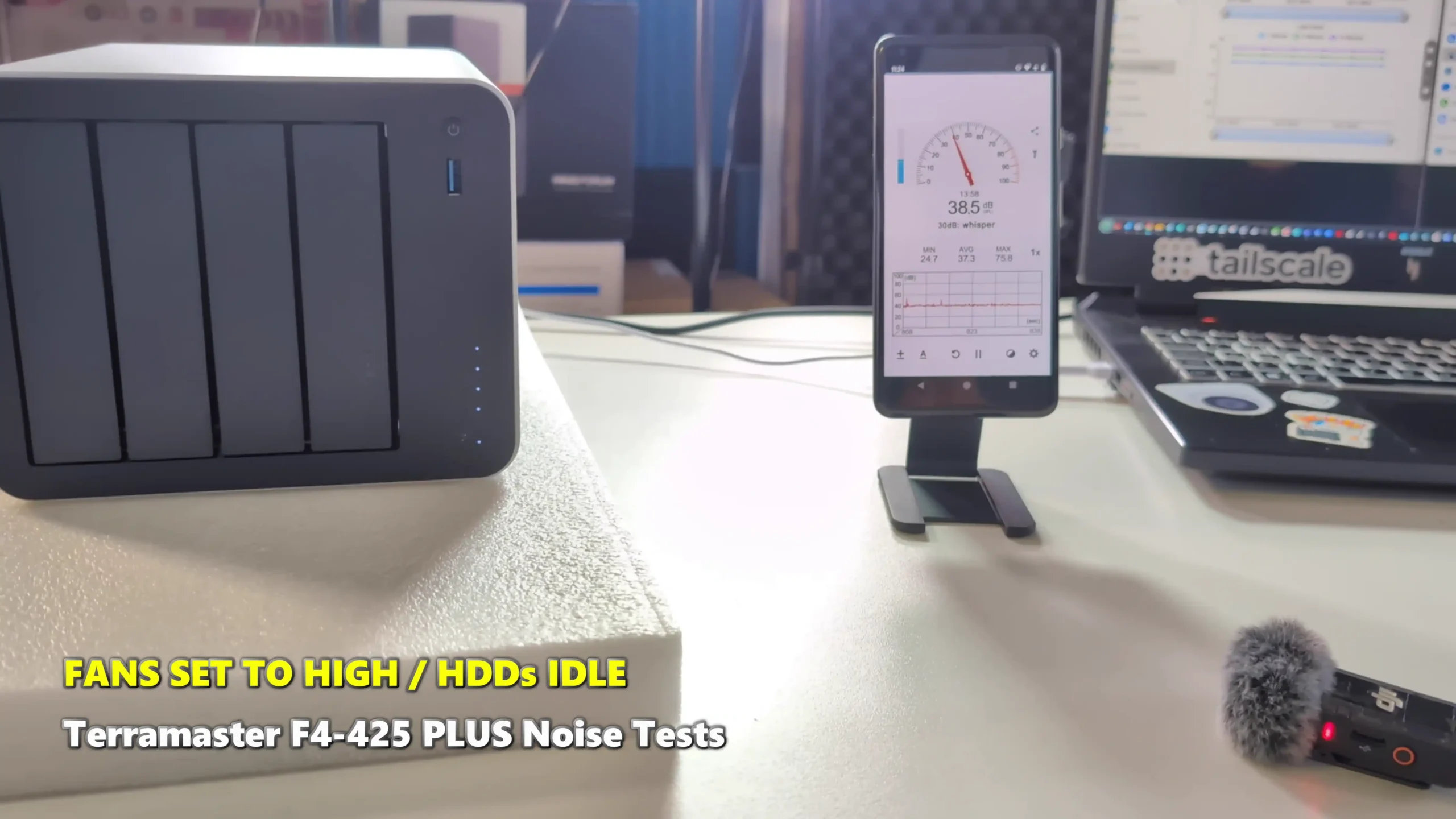 |
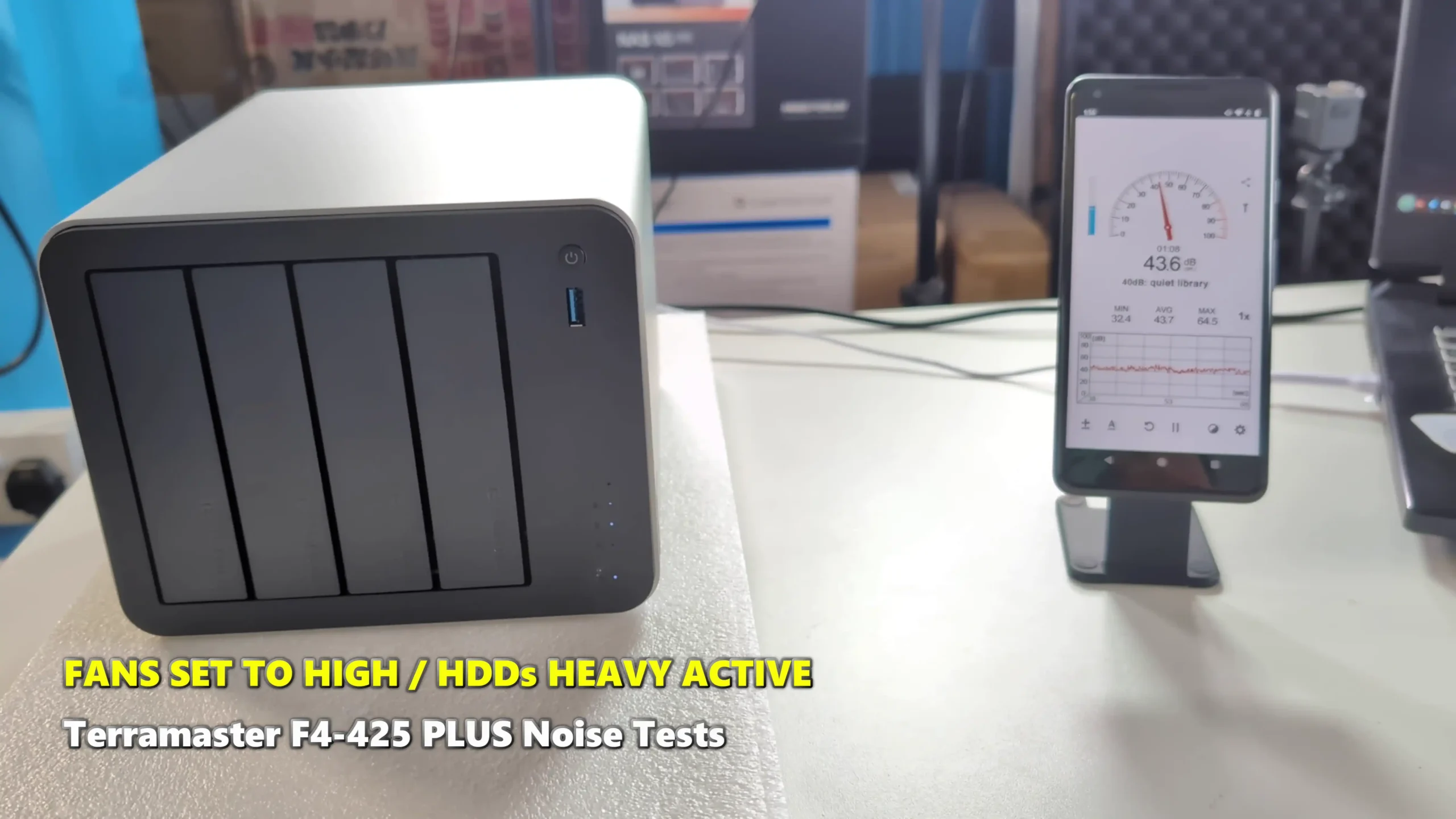 |
Thermal results further underscored the system’s stability. Surface readings from the aluminum body remained between 25°C and 27°C on average, while drive bays hovered at 28–30°C after extended workload sessions. The rear fan exhaust area reached approximately 36–38°C under sustained load. The efficient heat dispersion of the chassis prevented thermal throttling during prolonged transfers or virtualization testing, even with all seven storage devices active. This consistent temperature range indicates that TerraMaster’s choice of single-fan cooling and full-metal housing achieves a practical balance between noise, airflow, and longevity.
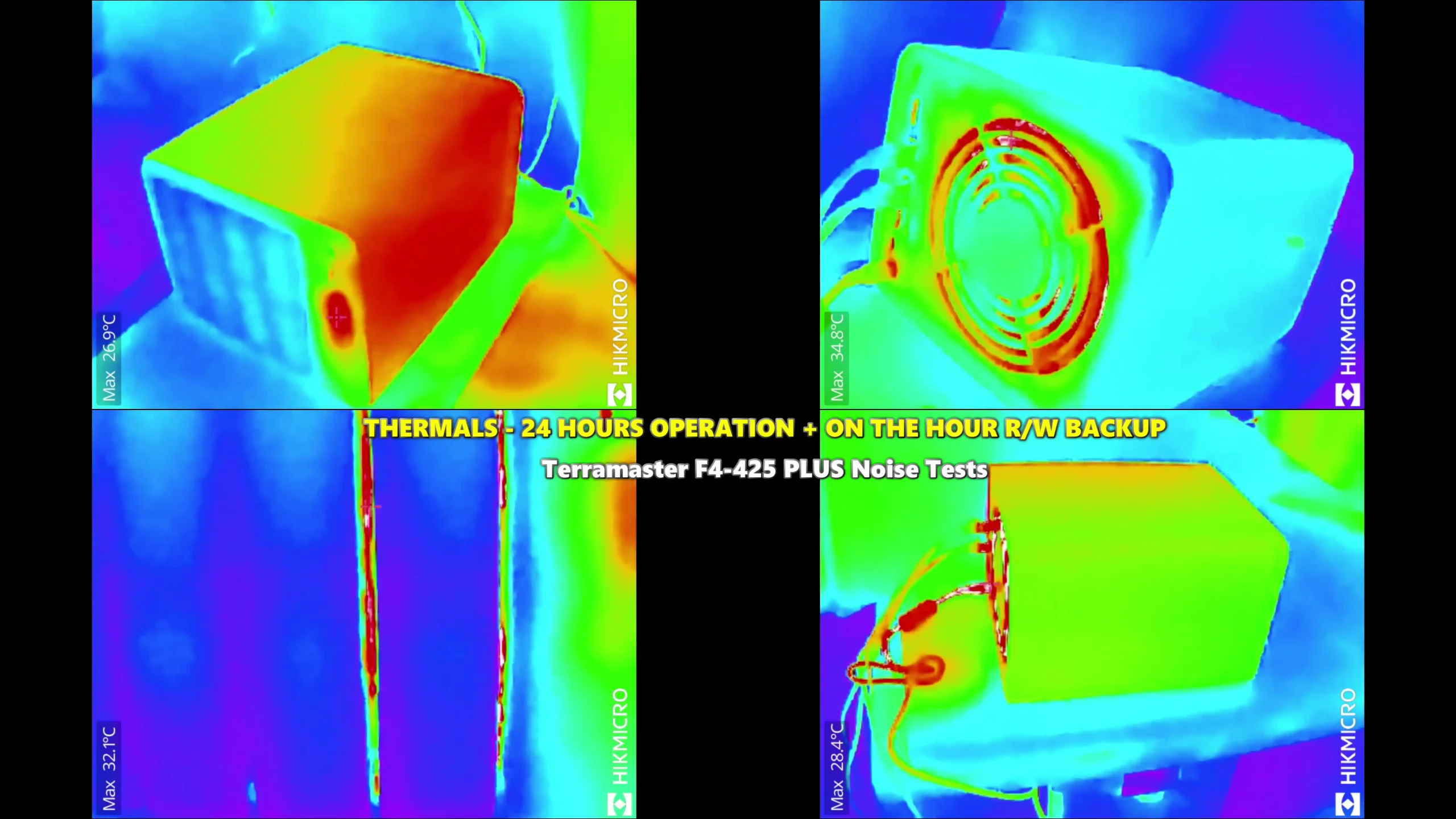
| Test Condition | Configuration | Observed Results |
|---|---|---|
| Network Throughput (HDD RAID 5) | 4 × Toshiba MG08 7200RPM HDDs | ~500–520 MB/s read/write (single 5GbE port) |
| File Transfer Test | 50.5 GB mixed media | 3m 45s total, 224 MB/s average |
| SSD Performance | 3 × NVMe Gen3 x1 | 800–900 MB/s per slot, ~1020 MB/s combined read |
| Power Consumption (Idle) | 3 × SSD, no HDD | 13.3 W |
| Power Consumption (Active) | 4 × HDD, CPU ~80% | 61–63 W |
| Noise Levels | Low–High Fan Speeds | 33–43 dB(A) |
| Temperature Range | 3-day uptime, mixed load | 25°C–38°C overall system temperature |
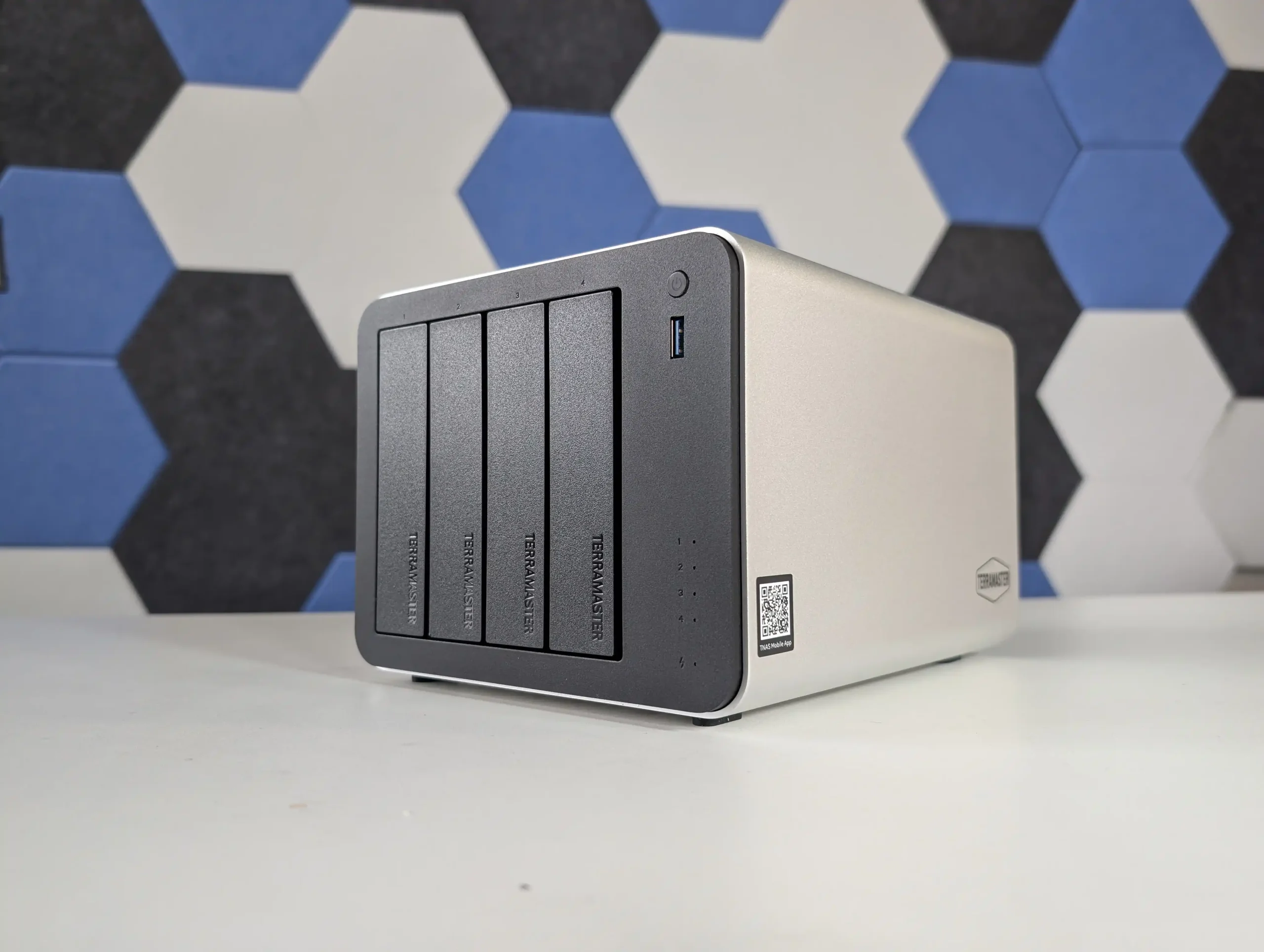
The Terramaster F4-425 PLUS NAS Review – Verdict and Conclusion
The TerraMaster F4-425 Plus demonstrates how far the company’s mid-range NAS lineup has progressed in terms of hardware refinement and real-world usability. By combining Intel’s efficient N150 processor with 16GB of DDR5 memory, dual 5GbE connectivity, and triple M.2 NVMe slots, it provides a specification normally reserved for higher-priced units. The build quality, centered around a full-metal chassis and quiet cooling design, contributes to consistent thermals and low power usage even under multi-day workloads. While the design omits premium touches like drive locks or redundant fans, the emphasis on practicality and efficient cooling makes it a dependable solution for continuous operation. From a user experience perspective, the integration of TOS 6 represents TerraMaster’s most stable and capable operating system to date, offering improved security features, cloud synchronization tools, snapshot management, and flexible storage configurations that appeal to both home and small office users.
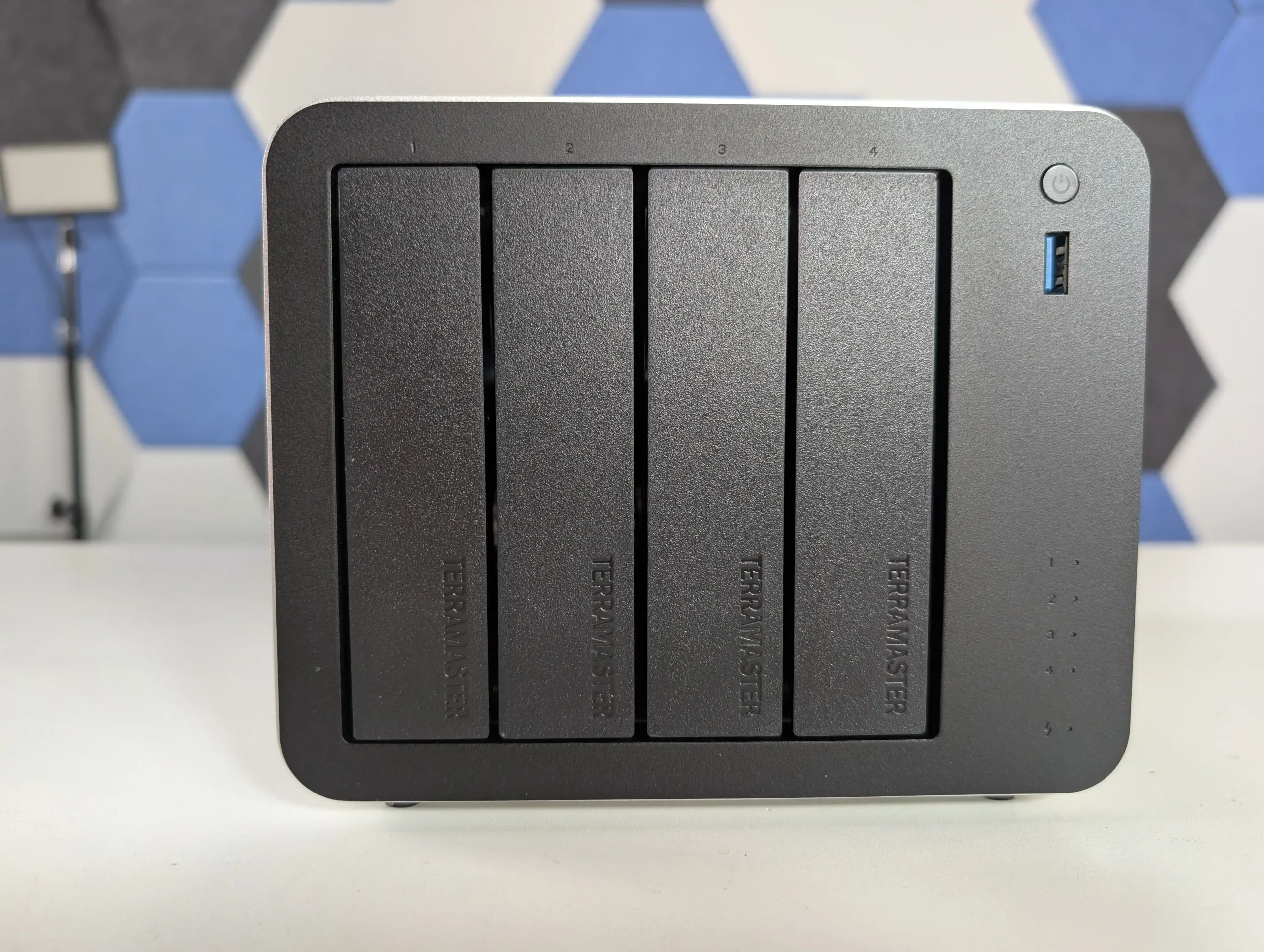
From a value standpoint, the F4-425 Plus stands out as one of the most competitively priced NAS units in its category. At $569.99, or $484.99 during the initial discount period, it delivers strong network and storage performance that aligns closely with rivals from Synology and QNAP while retaining open installation flexibility for third-party platforms such as Unraid or TrueNAS. Its combination of high-speed connectivity, compact design, and mature software environment makes it an appealing option for anyone seeking a 4-bay system capable of multitasking across media streaming, data backup, and light virtualization. Although it cannot fully match the polish of Synology DSM or the plugin ecosystem of QNAP QTS, TerraMaster has successfully positioned this device as a bridge between affordability and professional performance, solidifying its place as one of the more balanced NAS releases of 2025.
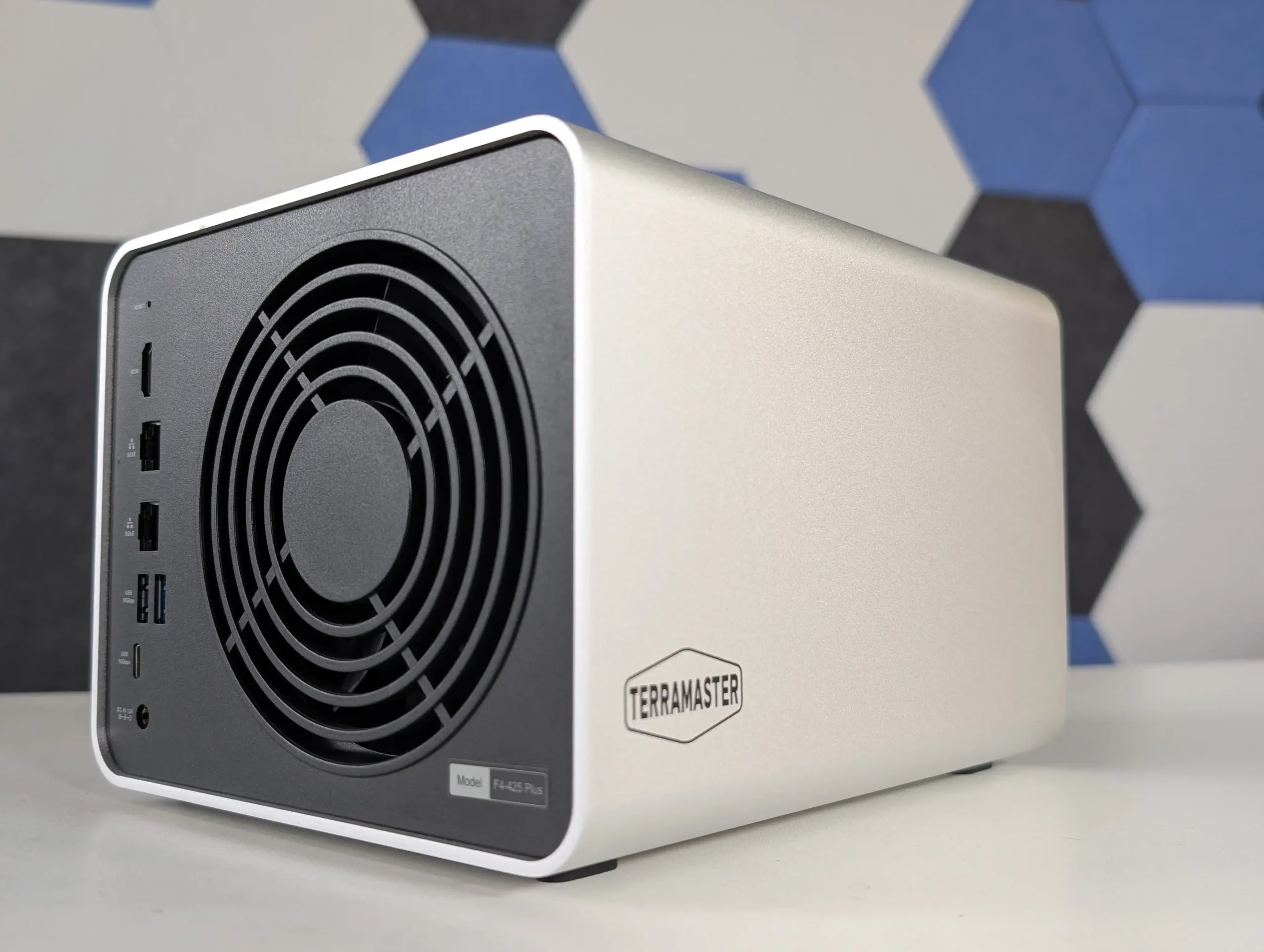
| Terramaster F4-425 PLUS NAS | ||
| Amazon in Your Region for the Terramaster F4 SSD NAS @ $569 ($489.99 till 19th Nov) | Terramaster F4-425 PLUS – $569 | B&H for the Terramaster F4-425 plus NAS @ $569.99 |
 |
 |
 |
| Terramaster F4-425 PLUS NAS PROs | Terramaster F4-425 PLUS NAS CONs |
| • Dual 5GbE network ports with full independent bandwidth for high-speed transfers + lots of USB-to-5GbE $30 upgrades in the market now • Three PCIe 3.0 x1 M.2 NVMe slots supporting cache or storage pool configurations • Intel N150 processor with integrated graphics enabling 4K hardware decoding and AES-NI encryption • 16GB DDR5 memory (expandable to 32GB) offering improved bandwidth and multitasking performance • Full-metal chassis with efficient thermals, low noise levels, and minimal vibration • Comprehensive RAID and storage management through TOS 6 with snapshot and HyperLock-WORM protection • Supports Docker, virtual machines, Plex, Emby, and Jellyfin natively within TOS 6 • Competitive pricing with strong value relative to Synology and QNAP alternatives |
• Cheaper N150 NAS Systems have arrived earlier in 2025 • 5GbE adoption is low, so only larger 10GbE ready groups (via auto-negotiation) will enjoy the benefits of 5GbE • TOS 6 interface and app ecosystem remain less polished than top-tier NAS platforms |
📧 SUBSCRIBE TO OUR NEWSLETTER 🔔
🔒 Join Inner Circle
Get an alert every time something gets added to this specific article!
This description contains links to Amazon. These links will take you to some of the products mentioned in today's content. As an Amazon Associate, I earn from qualifying purchases. Visit the NASCompares Deal Finder to find the best place to buy this device in your region, based on Service, Support and Reputation - Just Search for your NAS Drive in the Box Below
Need Advice on Data Storage from an Expert?
Finally, for free advice about your setup, just leave a message in the comments below here at NASCompares.com and we will get back to you. Need Help?
Where possible (and where appropriate) please provide as much information about your requirements, as then I can arrange the best answer and solution to your needs. Do not worry about your e-mail address being required, it will NOT be used in a mailing list and will NOT be used in any way other than to respond to your enquiry.
Need Help?
Where possible (and where appropriate) please provide as much information about your requirements, as then I can arrange the best answer and solution to your needs. Do not worry about your e-mail address being required, it will NOT be used in a mailing list and will NOT be used in any way other than to respond to your enquiry.

|
 |
Minisforum MS-02 Ultra - WHO IS THIS FOR??? (The First 48HRs)
Why People Use TrueNAS, UnRAID and Proxmox to Turnkey NAS (Synology, QNAP, etc)
Why People Prefer Turnkey NAS vs TrueNAS, UnRAID and More
The Top 5 Mistakes NAS Buyers Make
Top 5 PLEX/Jellyfin NAS of 2025
Seagate Ironwolf vs WD Red NAS Hard Drives
Access content via Patreon or KO-FI
Discover more from NAS Compares
Subscribe to get the latest posts sent to your email.


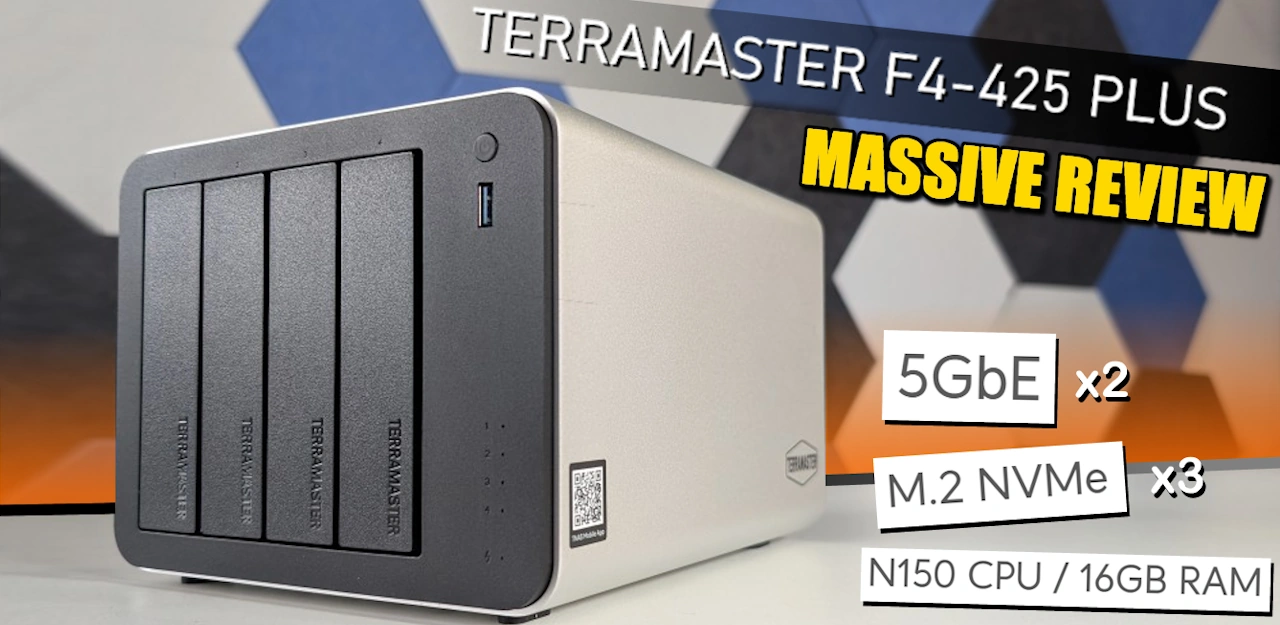



took a week to setup and run dockers and containers. 4 days ago the TOS (terra master operating system)
went down( 504 error code no access to TOS) spent hours diagnosing with tech support in China only to have to reset the f4-425 plus and re install TOS. Well four days later it has happened again the 504 error code and no access to TOS.
REPLY ON YOUTUBE
Can you use only nvme drives for storage?
REPLY ON YOUTUBE
The F4-425 Plus appears to be a rather good upgrade option.
REPLY ON YOUTUBE
I try watching a lot of your videos. I see one video where you compare NAS A to NAS B and another video where you compare NAS C to NAS D. But after all the specs and jargon get thrown around, I get a little confused and it’s hard for me to figure out what to get out of ALL the NAS brands. Have you every considered doing an across the board video where you’re picking from all NAS Brands? For instance, If I wanted to buy a 4-5 bay NAS box which system is the best across the board? Taking in account software, hardware, etc. Don’t factor in hard drive costs. Just tell me what the best box for $750 is or the best box for under $1K. Tell me what you would buy if you had $750 or $1K to spend.
REPLY ON YOUTUBE
You mentioned in cons that cheaper N150 NAS are available in the market. Which models are you referring to?
REPLY ON YOUTUBE
Support for TrueNAS installations?
REPLY ON YOUTUBE
Have you seen lot of difference between TOS6 and TOS7 ?
REPLY ON YOUTUBE
How works the cache system with SSD? Like ugreen? One for read or two for read and write ? Or one only for read and write ? Thx 🙂
REPLY ON YOUTUBE
Is it worth waiting for black Friday ?
It’s 510€ right now on Amazon france
REPLY ON YOUTUBE
Apps in a separate video? Why is that I wonder?????
REPLY ON YOUTUBE
PS, I decided not to wait for the comparison with the UGreen 4800+ but forgot to use your link. Paypal $$$ heading your way with thanks.
REPLY ON YOUTUBE
Bought it for great specs, planned to run unraid… Cancelled the order a day later..
Despite everything in the fantastic review: I can’t verify if Chinese government induced hardware tampering will compromise my data at some point. Trust is everything.
REPLY ON YOUTUBE
I bought Synology 1525+ after they removed the hardware restrictions, now saw this. I still can return it. Help me to decide please. I want to run docker container, macbook time machine and iphone backups, and I want flawless run and forget solution. Please help❤
REPLY ON YOUTUBE
I’m still going to hold out and wait until QNAP releases a new 2026 NAS to properly replace the TS-x64 series.
REPLY ON YOUTUBE
Three M.2 is a big deal to me!
REPLY ON YOUTUBE
This looks like OS upgrade is much more than HW changes. I see it as best contender with DSM – it has 90% of native applications as Synology. Active backup, VM backup /i still miss Proxmox PVE support/, iSCSI, NVME as native storage…. I might give it a try with new 425 series when they update Pro model to 425. Thank you for useful review.
REPLY ON YOUTUBE
Really nice review! However, I’m new to NAS devices, selected specific ones from Synology, QNAP and TerraMaster, but still not sure about their OSes. Reviews usually don’t cover deeply SW aspects, especially specific ones. I mainly need the following functionality/apps/tools (and polished as much as possible): scheduled PC / OS imaging / backup (Windows, and Linux is possible), scheduled cloning from external and built into PC drives/disks with versioning of changes, integrity checks. Am I right that DSM fits me best than others like TOS, etc.?
REPLY ON YOUTUBE
Holy bytes, I think I’m in love.
This model just jumped to the top of my list of potential replacements for my DS920+.
REPLY ON YOUTUBE
Legend has it the first word of each chapter is the answer to next week’s question
REPLY ON YOUTUBE
was considering the F4-424 Max to replace my slightly aging QNAP TS-453A but this maybe woth a look
REPLY ON YOUTUBE
It’s called Nas compare. Can you please compare? F2-425 to F2-424
REPLY ON YOUTUBE
Well now I know I can’t trust you. Not mentioning Ugreen at all is a dead giveaway you’ve agreed to omit them from this Terramaster advertisement.
REPLY ON YOUTUBE
Be aware that third party OS is not always a straight forward install on the Terramaster, as some make it out to be.
REPLY ON YOUTUBE
TerraMaster F4-425 Plus power consumption testing shows idle power as low as 11W, making it energy-efficient and environmentally friendly—a significant improvement over previous NAS models.
TerraMaster F4-425 Plus power consumption testing shows idle power as low as 11W, making it energy-efficient and environmentally friendly—a significant improvement over previous NAS models.
REPLY ON YOUTUBE
TerraMaster F4-425plus NAS features a substantial 16GB DDR5 memory, making it ideal for professional video editors.
REPLY ON YOUTUBE
Thank you for your video. I’ve already purchased the Terramaster F4-425 Plus right away and am waiting for it to arrive. I recommend it to others who need local backups—I think it’s very suitable for photographers to store photos.
REPLY ON YOUTUBE
Finally, the upgraded version of the F4-424 is here. TerraMaster didn’t let me down.
REPLY ON YOUTUBE
Finally, the upgraded version of the F4-424 is here. TerraMaster didn’t let me down.
REPLY ON YOUTUBE
I bought the TerraMaster F4-425plus right away, and I recommend it to others who need local backups. I think it’s perfect for photographers to store photos.
I purchased it immediately. TerraMaster F4-425 Plus is very quiet, with barely any fan noise, making it ideal for placement in the living room.
TerraMaster’s TOS 6 system features an intuitive interface and a robust App Center, making it ideal for home media servers.
REPLY ON YOUTUBE
i kinda like this.. when price drops a bit in future think it really has a good spot. if it had a bit better price it’d be a banger
REPLY ON YOUTUBE
i kinda like this.. when price drops a bit in future think it really has a good spot. if it had a bit better price it’d be a banger
REPLY ON YOUTUBE
i kinda like this.. when price drops a bit in future think it really has a good spot. if it had a bit better price it’d be a banger
REPLY ON YOUTUBE
A cost-effective NAS!
REPLY ON YOUTUBE
Thanks for this quick intro Robbie. Looking forward to the TOS 6.0 deep dive as I’m running TOS 6 on my F4-423 and it’s a night and day upgrade from the TOS 4 F4-210 I was using before.
I’m running 4x 8TB Seagate’s in a RAID-5, 1 64GB SSD for the OS, 1 64GB SSD for cache of the RAID (both SSD’s are old OPTANE’s I had laying around unused).
REPLY ON YOUTUBE
My review unit has been a ????
REPLY ON YOUTUBE
Not trunked connection. Its either bonded, LAG or etherchannel
REPLY ON YOUTUBE
Why would I want such a powerful NAS? Isn’t it better to have a powerful server and let the NAS do only what’s supposed to do?
REPLY ON YOUTUBE
Many Thanks for the review . But Terramaster doesn’t have good operating system.
REPLY ON YOUTUBE
It’s a nice upgrade from their entry-level NAS I will say. The addition of the m.2, 16GB RAM, and 5GbE is the difference between a NAS that will limit you, and one someone can grow into. I’m still evaluating my unit, but my initial impression is positive. Still on the fence about the drive trays – the third iteration I’ve seen from TM. TOS 6 is a known factor, and I’ll throw TrueNAS and Proxmox on it soon. Factoring in the limits (m.2 lanes, single SODIMM, 4 core CPU) it’s a solid mid-tier offering. As you say, competition will be fierce in this space I predict.
REPLY ON YOUTUBE
Ubiquiti should’ve put a 5Gbe port on the UNAS 4
REPLY ON YOUTUBE
Hell yes. I’ve been so excited for this review.
REPLY ON YOUTUBE
I feel like you’re very nitpicky about the software compared to how you reviewed UGOS
REPLY ON YOUTUBE
A comparison with the Ugreen 4800 Plus would be a very worthwhile video.
REPLY ON YOUTUBE
8:55 – appreciate extra vibroisolation from the table during the sound test
REPLY ON YOUTUBE
can someone explain to me why no nas company uses ecc anymore? i cant find any information other than some forum guys who praise ecc to death so i dont get why noone else mentions or uses it these days? should i build a nas myself just to get ecc or is it not that important as noone seems to use it anymore
thanks
REPLY ON YOUTUBE
5Gb network switches seem rare though. Never seen one.
REPLY ON YOUTUBE
Please cover the new Plex UI to bring more attention to what they have done
REPLY ON YOUTUBE
Can’t wait to hear about sr unity vs Ugreen. I’m ready to buy a dxp 4 bay but this looks like a great alternative
REPLY ON YOUTUBE
If it had an Intel N5095 and 6 bays or more I’d be interested. 4 bays and an Intel N150 not so much.
REPLY ON YOUTUBE
Minisforum N5 Pro 48GB idle power consumption is 15-16watts with 4 FireCuda 530R 2TB NVME and 2 Seagate Exos X20 20TB in idle. I was thinking about getting F4-425 Plus as backup but idle power feels a little bit high to me. Anyway thanks for the review much appreciated.
REPLY ON YOUTUBE
I’m still looking for anything that comes close to that aoostar with the 5825 in it, that chip is a beast for a nas, and only $400
REPLY ON YOUTUBE
With N150 CPU that has only 9 PCIe lanes and each SSD having only PCIe 3.0 x1, it’s hardly a good option. Ugreen 4800 Plus similarly priced has Pentium CPU with 20 lanes.
REPLY ON YOUTUBE
lol the spec can mob $ynology on the floor.
REPLY ON YOUTUBE
Serious question. What is the deal with Chinese NASs? Do people feel that they’re safe or they’re a security risk? It does seem like Chinese government policy encourages baked in spyware.
REPLY ON YOUTUBE
For someone like me who is doing photo/video that has no experience in Nas’s. Would you go for thisone or rather go for the Ugreen 4800 Plus or maybe the 6800 Pro from Ugreen?
I’m already looking weeks of footage, but I’m still not sure..
Never had a NAS (I do have 22TB in my pc tho)
REPLY ON YOUTUBE
Holy video chapters, Batman!
REPLY ON YOUTUBE
First
REPLY ON YOUTUBE